Physical Address
304 North Cardinal St.
Dorchester Center, MA 02124
The larynx plays a central role in coordinating the functions of the upper aerodigestive tract, including respiration, speech, and swallowing. The larynx is the second most common site for squamous cell carcinoma in the head and neck, which is causally related to tobacco and alcohol exposure. The larynx is divided into supraglottic, glottic, and subglottic regions ( Fig. 10.1 ). These anatomic divisions are based on embryologic development and have important clinical implications. Lymphatic drainage of the supraglottic larynx is very rich compared with the scanty lymphatic network in the submucosal plane of the true vocal cords. The patterns of regional spread of laryngeal cancer therefore depend on the site of origin and the local extent of the primary tumor. Each of the three regions of the larynx is divided into various sites ( Fig. 10.2 ). The sites in the supraglottic region are the laryngeal surface of the epiglottis, the aryepiglottic folds, the arytenoids, the ventricular bands or false vocal cords, and the ventricles, which are potential spaces between the false and true vocal cords. In the glottic larynx, the right and left vocal cords and anterior commissure represent the three designated sites. The subglottic region is generally considered as one site and is divided into its right and left lateral walls.
Squamous cell carcinomas constitute more than 95% of primary malignant tumors of the larynx. The remaining tumors are those arising from the minor salivary glands, neuroepithelial tumors, soft tissue tumors, and, rarely, the cartilaginous laryngeal framework. In 2018, the American Cancer Society estimated that approximately 13,150 new cases of cancer of the larynx would be diagnosed in the United States, which represents 0.8% of all new cancers. Death rate estimates vary, depending on the site and stage of the primary tumor. Overall, 3,710 cause-specific deaths for cancer of the larynx were estimated for 2018 in the United States. Worldwide, the incidence of laryngeal cancer varies in different countries ( Fig. 10.3 ). Southern Europe has by far the highest incidence of laryngeal cancer in men in the world. The geographic variation in the incidence rates and anatomic site distribution may be a reflection of lifestyle and habits of the patient population in different parts of the world, as well as other environmental factors.
The site distribution of larynx cancer is shown in Fig. 10.4 . The glottic region is by far the most common site for primary malignant tumors in the larynx. The stage distribution of patients with supraglottic carcinoma and glottic carcinoma at the time of presentation at Memorial Sloan Kettering Cancer Center is shown in Figs. 10.5 and 10.6 . Nearly 75% of patients with glottic carcinoma have localized disease at the time of diagnosis, in contrast to nearly 70% of patients with supraglottic carcinoma who have advanced disease at presentation.
The age distribution of larynx cancer cases from the SEER (Surveillance, Epidemiology, and End Results) database in the United States from 2010-2014 shows peak age between the 5th to 7th decade of life ( Fig. 10.7 ). The trend in incidence, mortality, and 5-year relative survival are shown in Fig. 10.8 . Since 1975 the incidence of larynx cancer has declined, and this has been associated with a progressive decline in mortality from larynx cancer. However, the 5-year relative survival has not improved over this time period. The 5-year relative survival for cases diagnosed from 1975 to 1977 was 66%, for cases diagnosed 1987 to 1989 was 66%, but for cases diagnosed 2006 to 2012 was 62%. This may account for other causes of death, including treatment-related morbidity and mortality as a result of increasing use of nonsurgical larynx preservation treatment programs.
Patients with primary tumors of the larynx usually present with complaints of hoarseness, discomfort in the throat, dysphagia, odynophagia, the sensation of something stuck in the throat, occasional respiratory obstruction, hemoptysis, or referred pain to the ipsilateral ear. The diagnosis in most instances is made by a thorough clinical examination using a rigid telescope or flexible fiber-optic laryngoscope, which allows adequate assessment of the surface extent of the primary tumor and mobility of the vocal cords. When lesions of the larynx are described, it is advisable to document them by a photograph or to depict them on a drawing to precisely demarcate the site and the local extent of the lesion. It is vitally important to specifically designate the site of origin of the primary lesion with its local extension to adjacent sites within the same region of the larynx or from one region to another region. Bulky lesions may extend beyond the larynx into the adjacent base of the tongue, pyriform sinus, or postcricoid region. This initial documentation is important not only for surgical treatment planning, but more so if the patient is to be treated by a nonsurgical larynx preservation program with chemoradiotherapy to assess response to therapy and for subsequent comparison during follow up.
The endoscopic appearance of a normal larynx is shown in Fig. 10.9 . Benign polyps have a smooth, glistening appearance with varying degrees of mucosal vascularity. They may be sessile or pedunculated and usually present on the true vocal folds ( Figs. 10.10 and 10.11 ). Reinke's edema presents as pseudopolyps and often is bilateral ( Fig. 10.12 ). Postintubation granulomas and benign inflammatory conditions also may present as polypoid lesions ( Figs. 10.13 through 10.15 ). Granulomas of the vocal cord also can occur as a foreign body reaction resulting from injection of Teflon for medialization of a paralyzed vocal cord ( Fig. 10.16 ). Squamous papillomas may have an appearance that is similar to that of a carcinoma ( Fig. 10.17 ). Epithelial neoplasms often present as whitish or erythematous, flat or exophytic lesions. These lesions may represent benign keratoses, premalignancy, or invasive cancer ( Figs. 10.18 through 10.28 ). Other submucosal lesions have a characteristic appearance with an intact overlying mucosa, such as a hemangioma ( Fig. 10.29 ). Subglottic lesions may be sometimes visible by indirect laryngoscopy with a flexible laryngoscope in the outpatient setting ( Fig. 10.30 ). However, accurate assessment of the true extent of the lesion requires laryngoscopy under anesthesia. Direct laryngoscopy with the use of rigid telescopes (0, 30, 70, and 120 degrees) or an operating microscope provides an excellent and detailed view of the lesion ( Fig. 10.31 ). For supraglottic lesions, extension of the tumor beyond the larynx into the adjacent base of the tongue, pyriform sinuses, or postcricoid region should be assessed. For lesions involving the laryngeal surface of the epiglottis, its inferior extent in relation to the anterior commissure is very important. Subglottic extension of glottis or transglottic cancers is crucial to accurately stage the tumor and plan definitive treatment. Accurate evaluation of the primary tumor in this manner prior to initiating treatment is vitally important, especially if any voice-sparing surgical procedure is a consideration. Finally, the precise nature of the lesion requires a representative biopsy for histologic diagnosis.
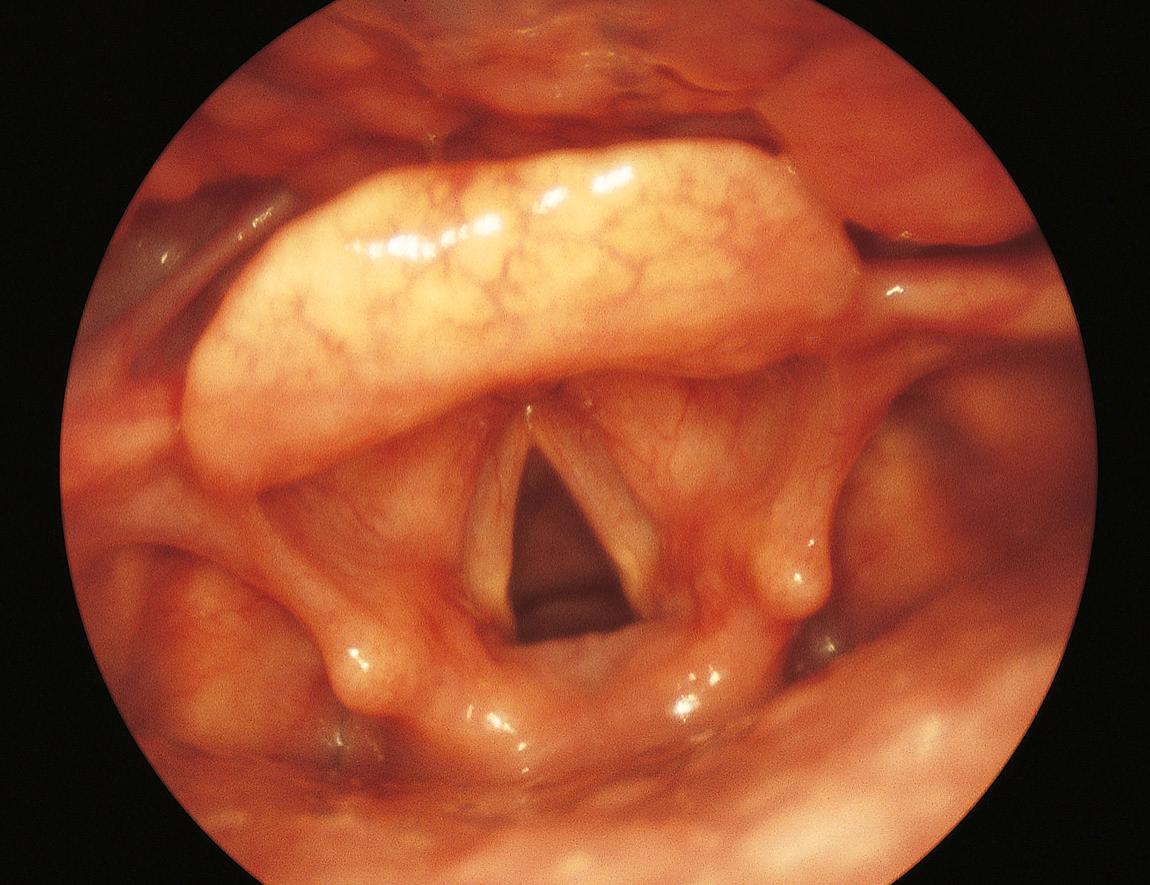
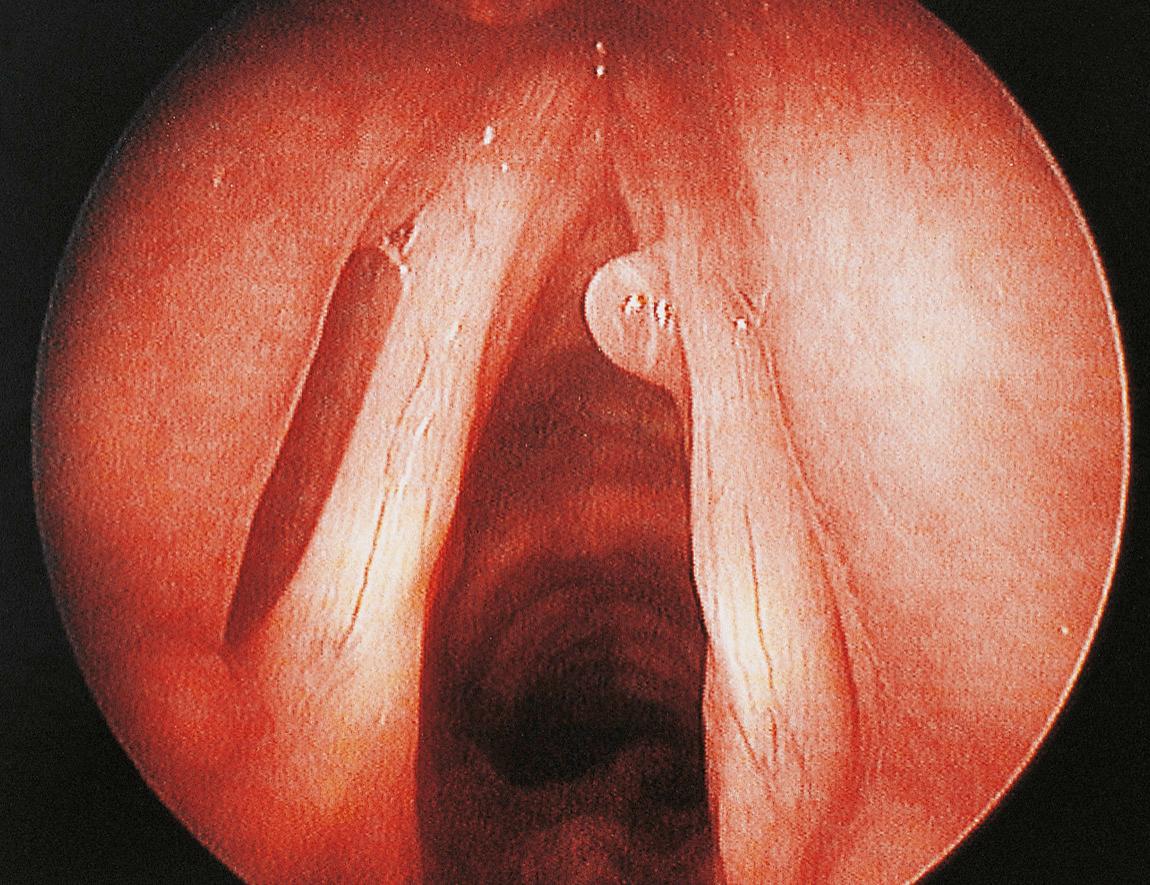
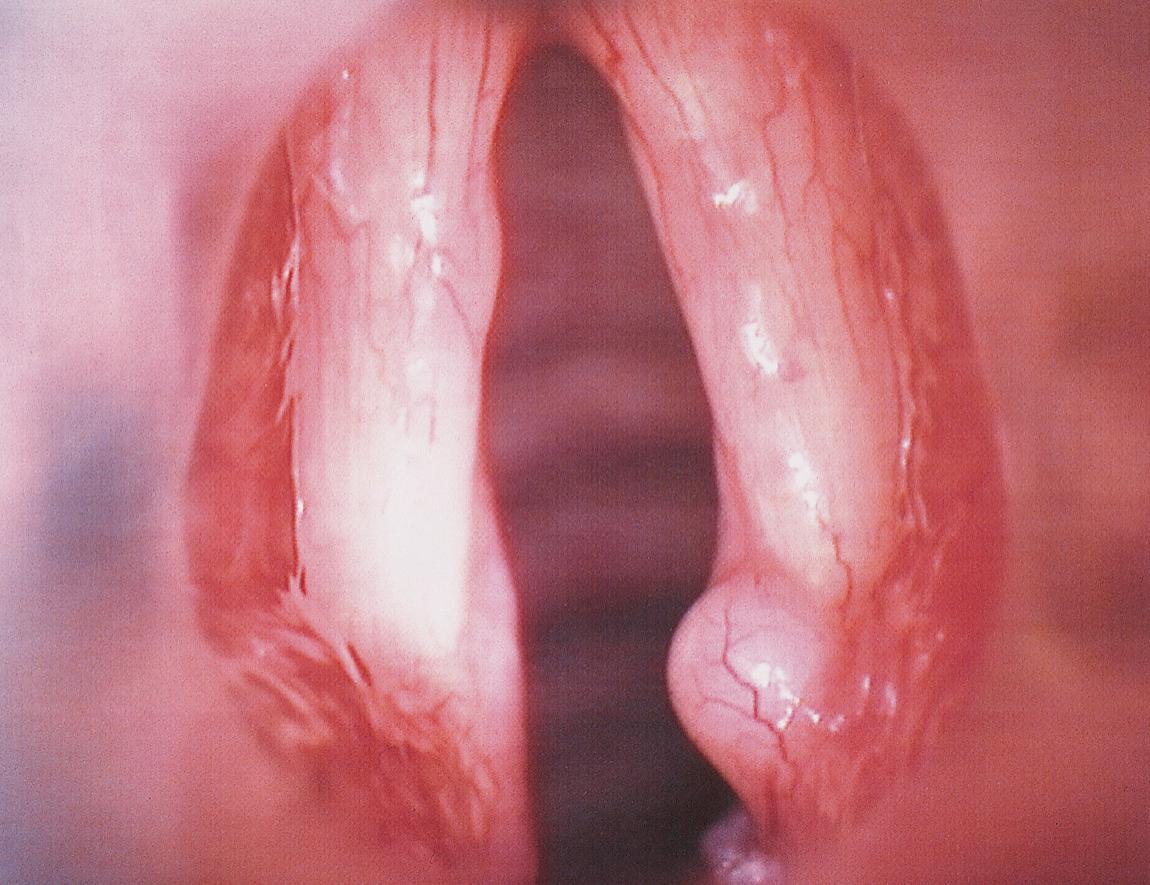
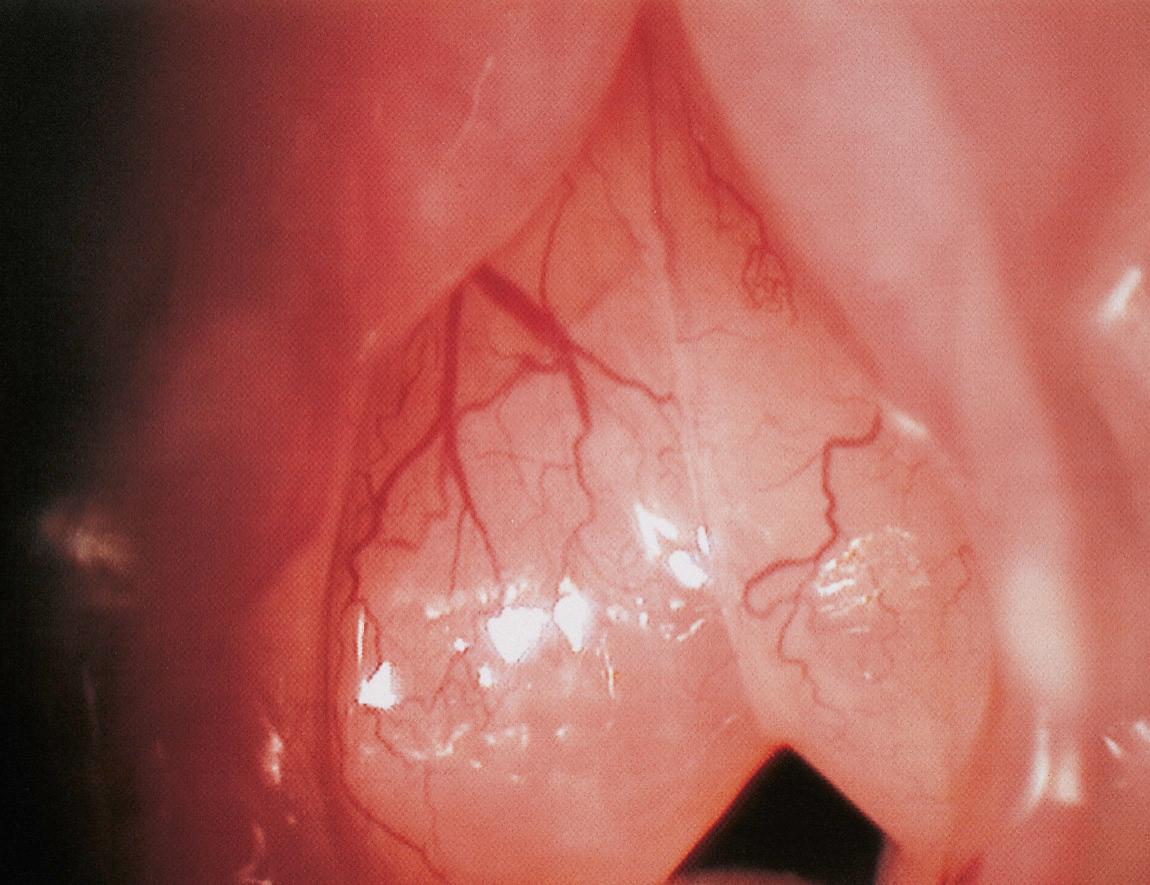
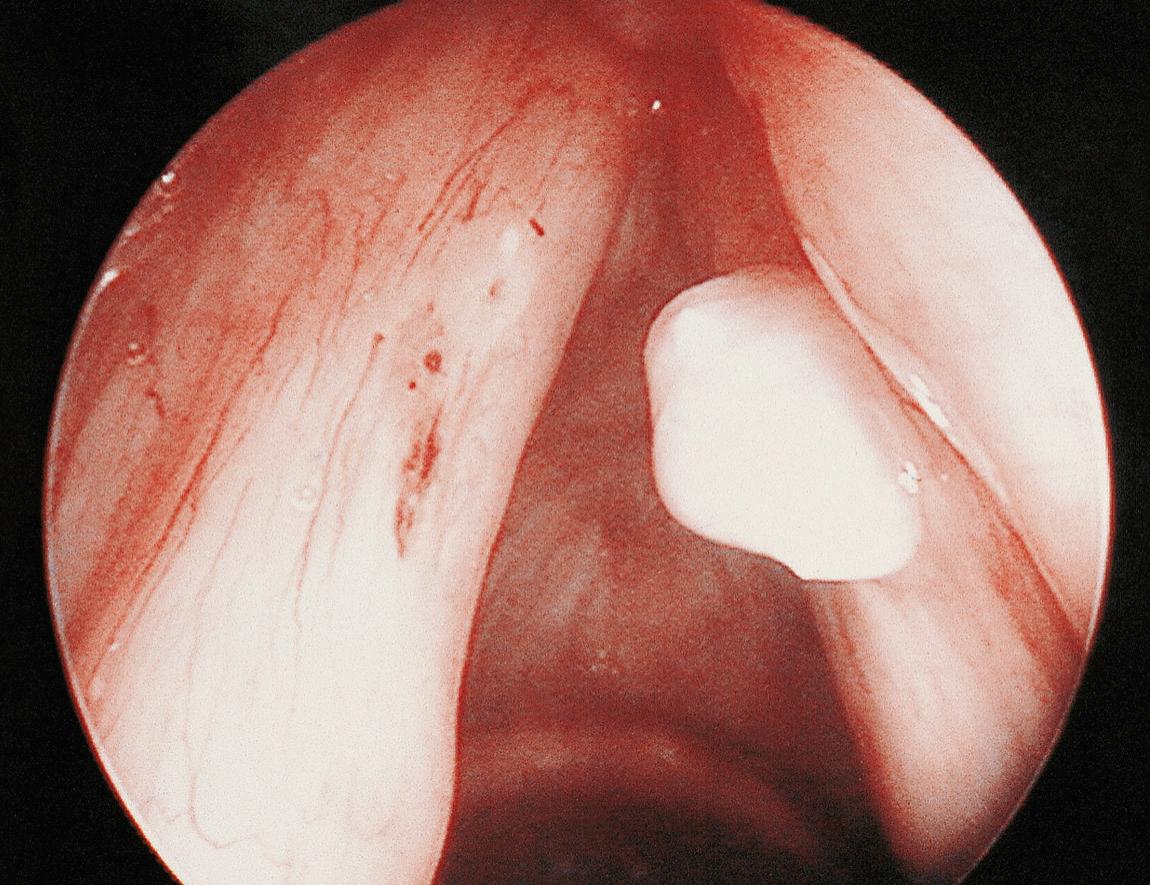
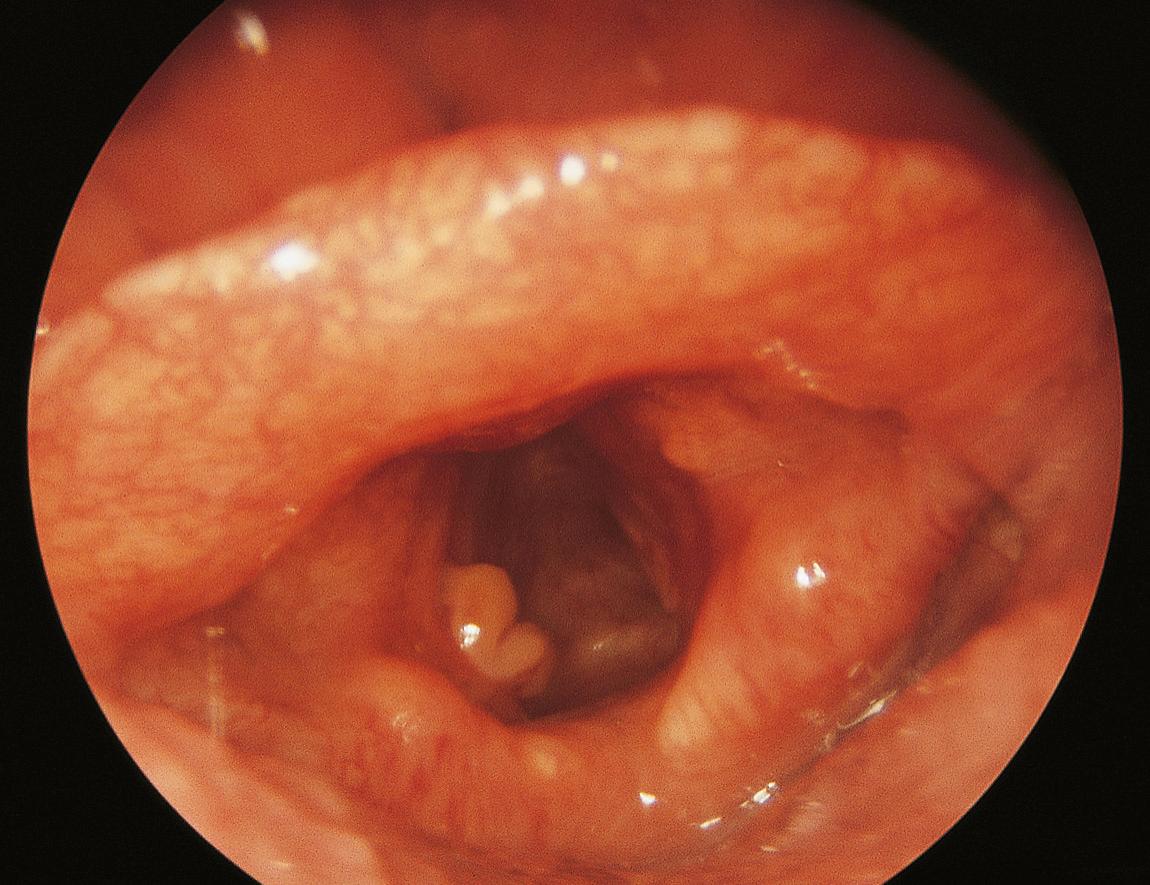
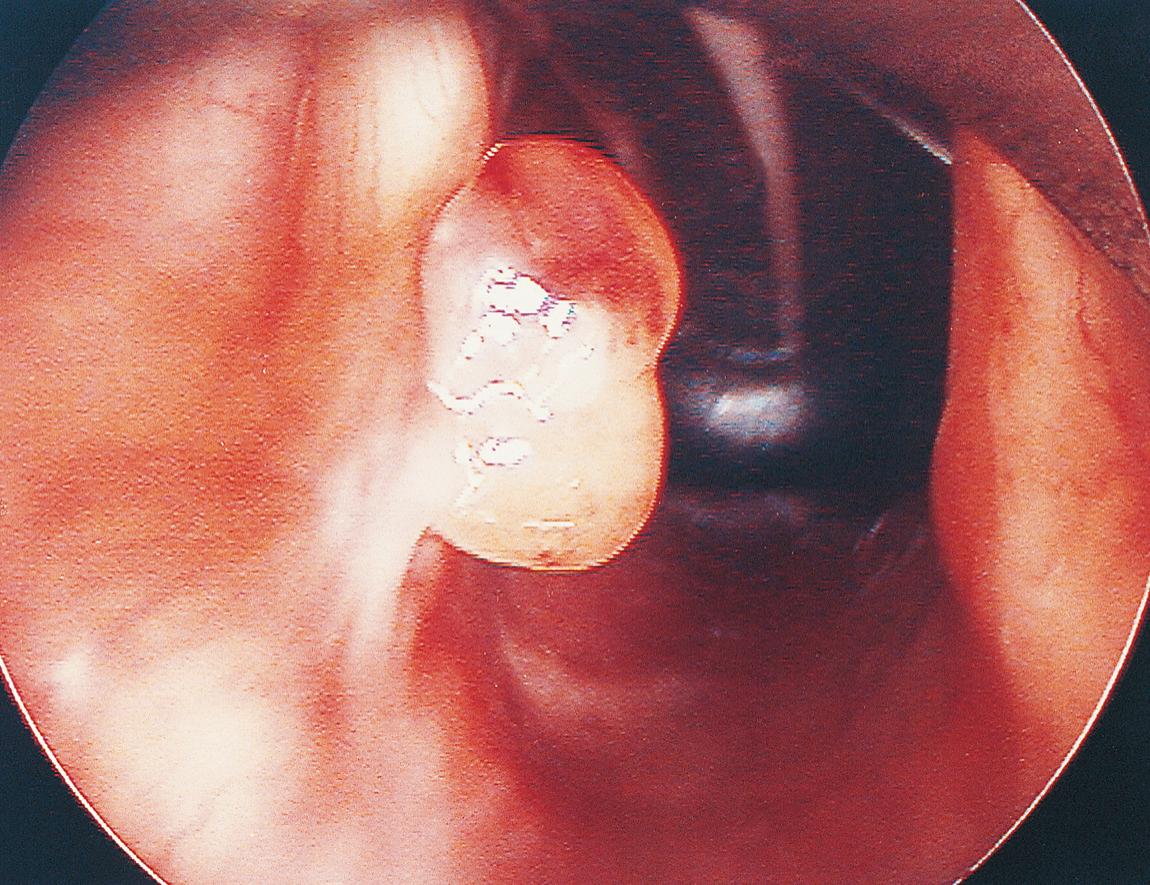
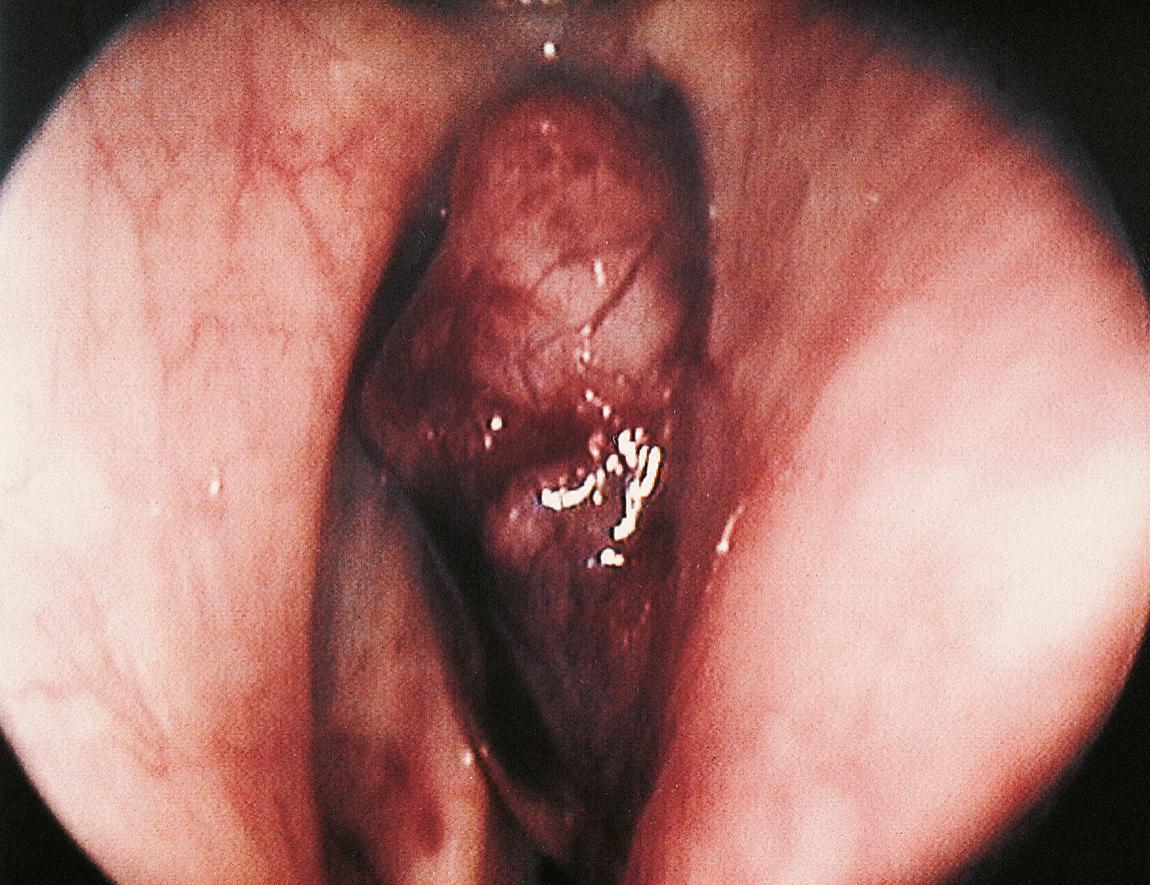
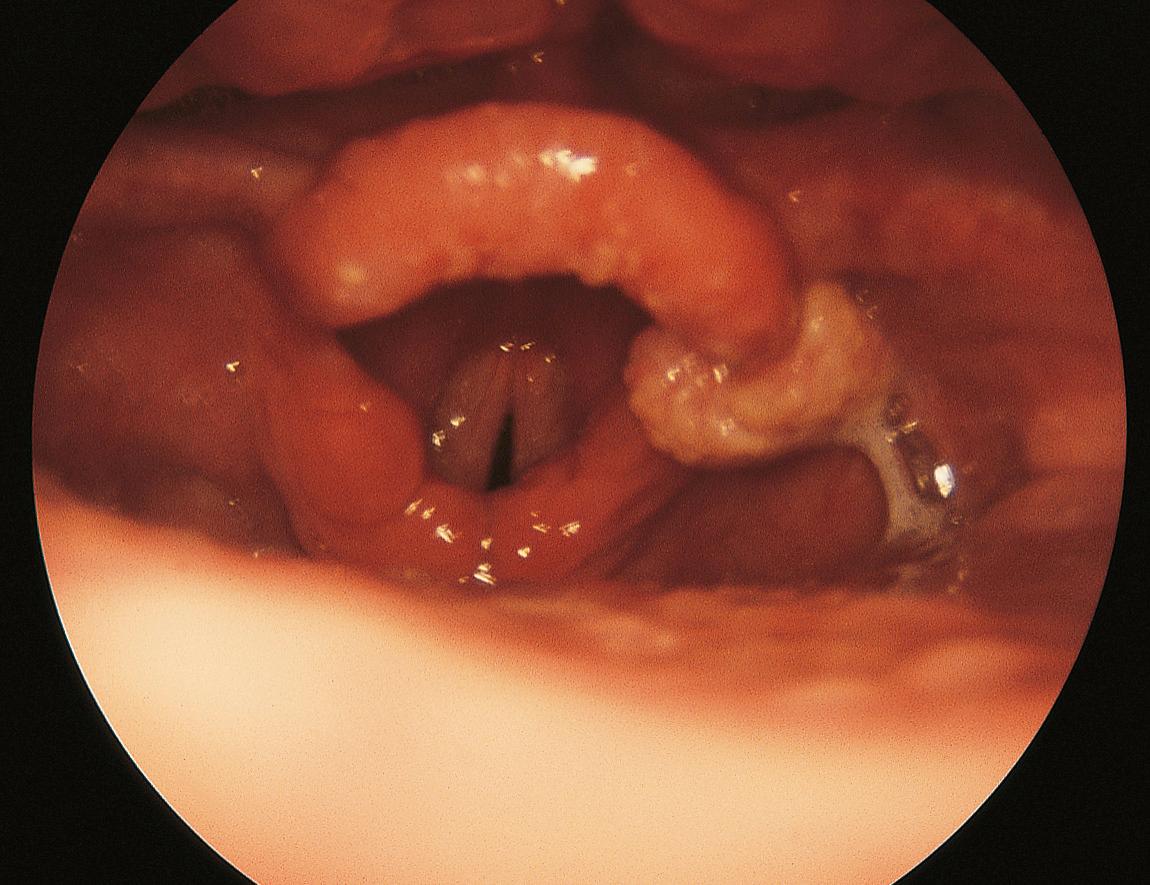
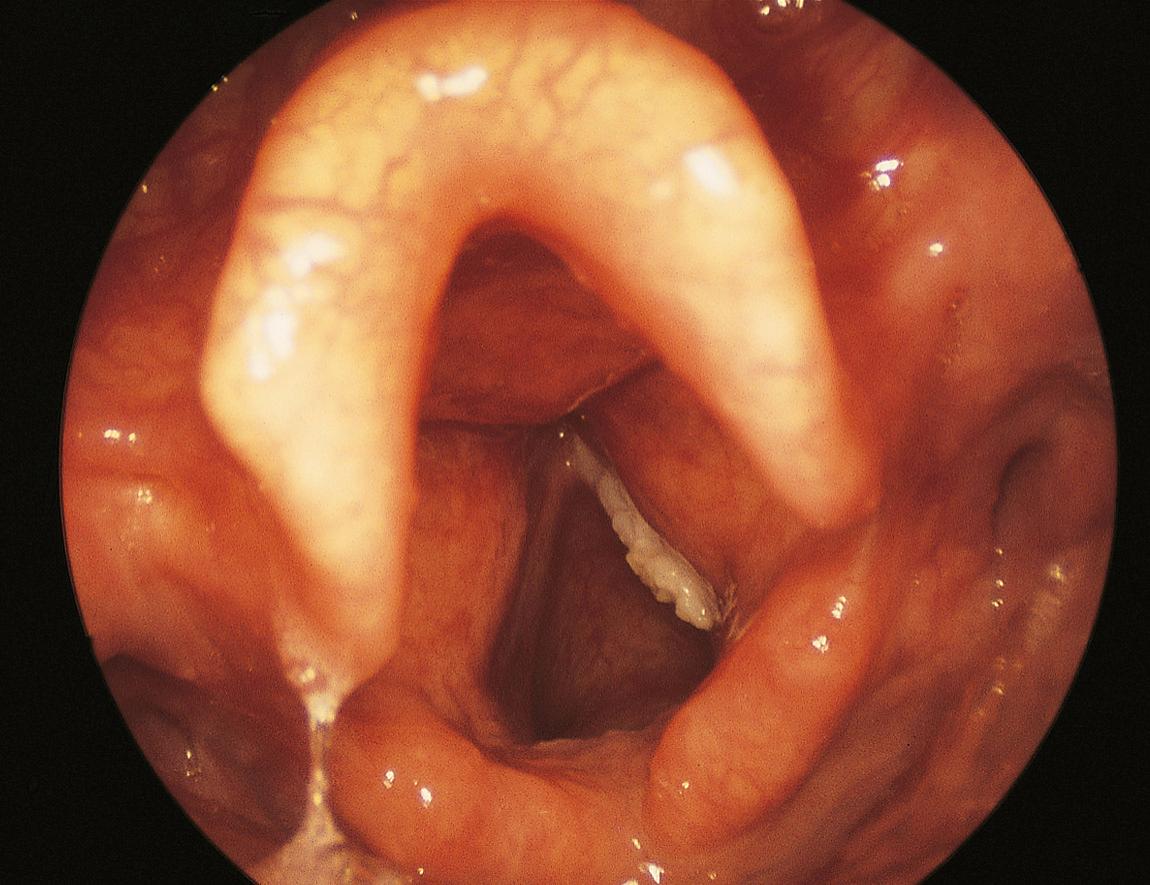
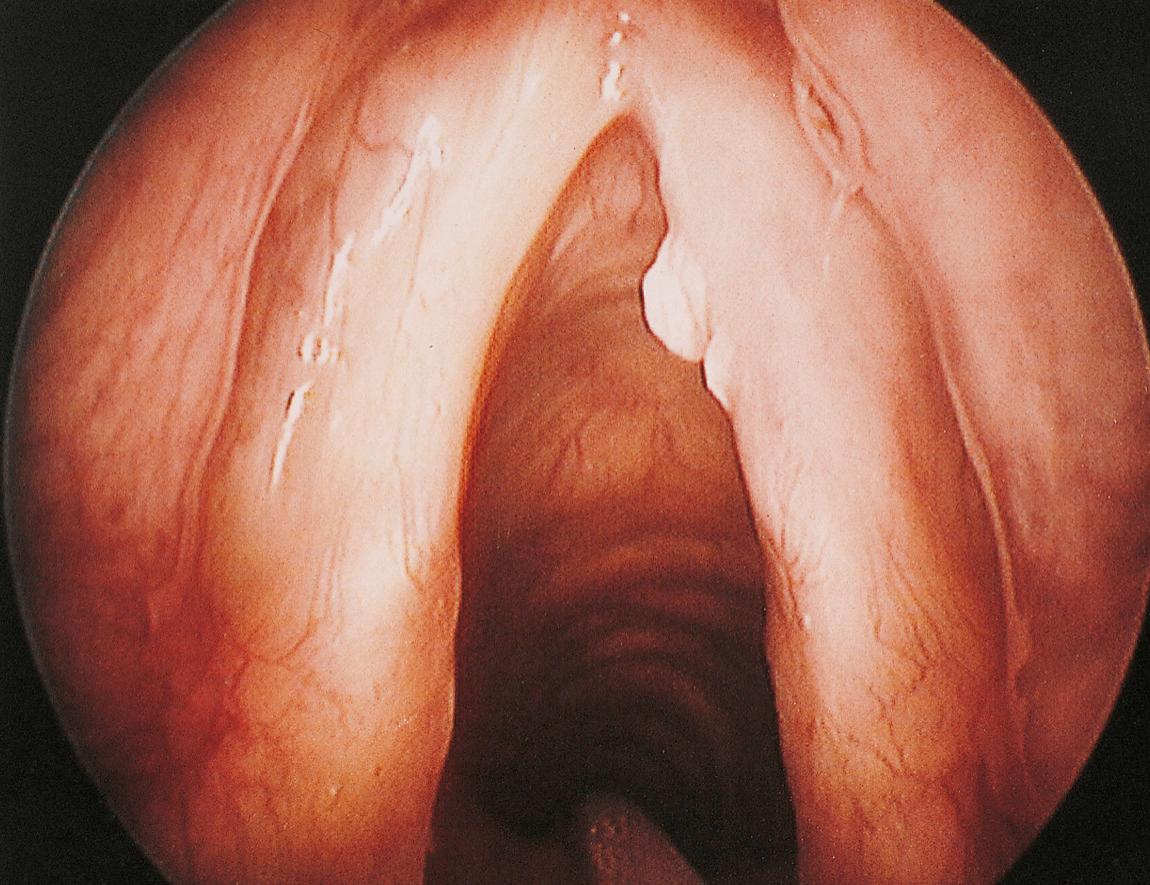
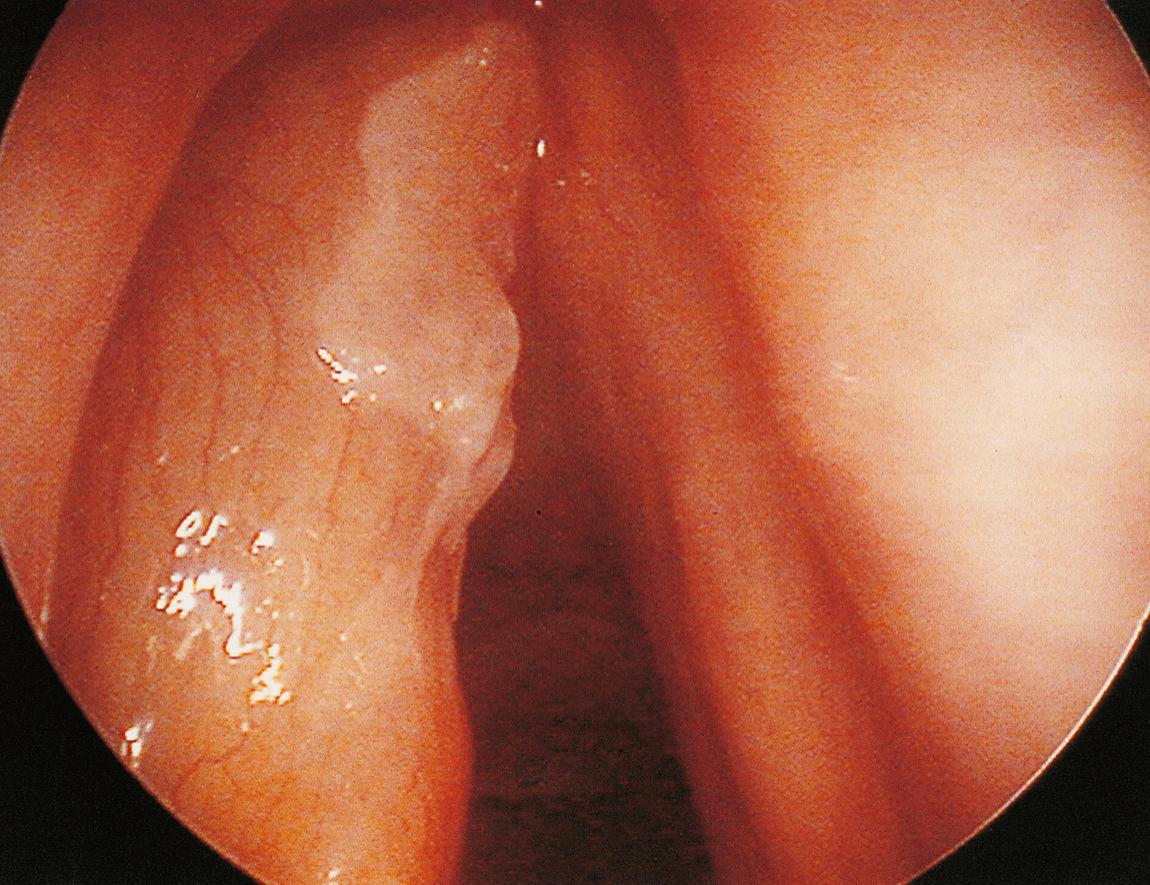
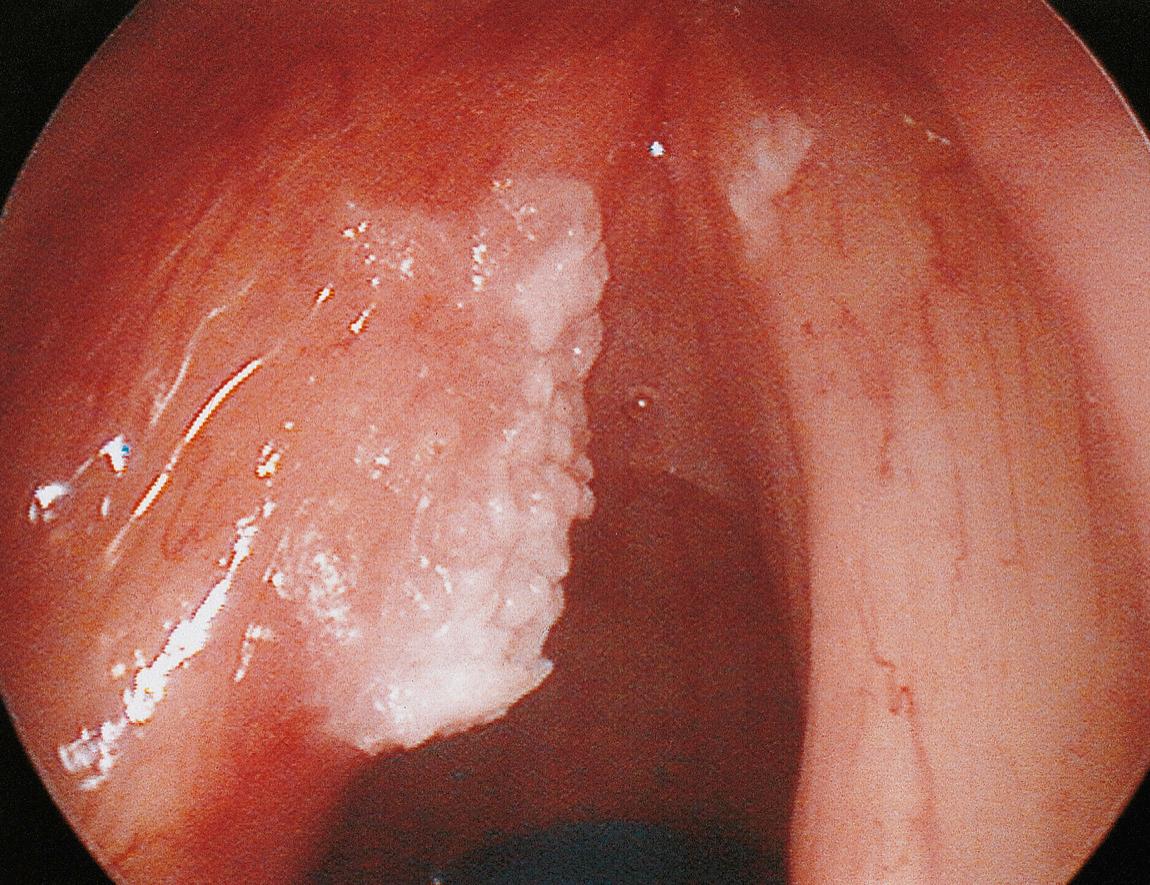
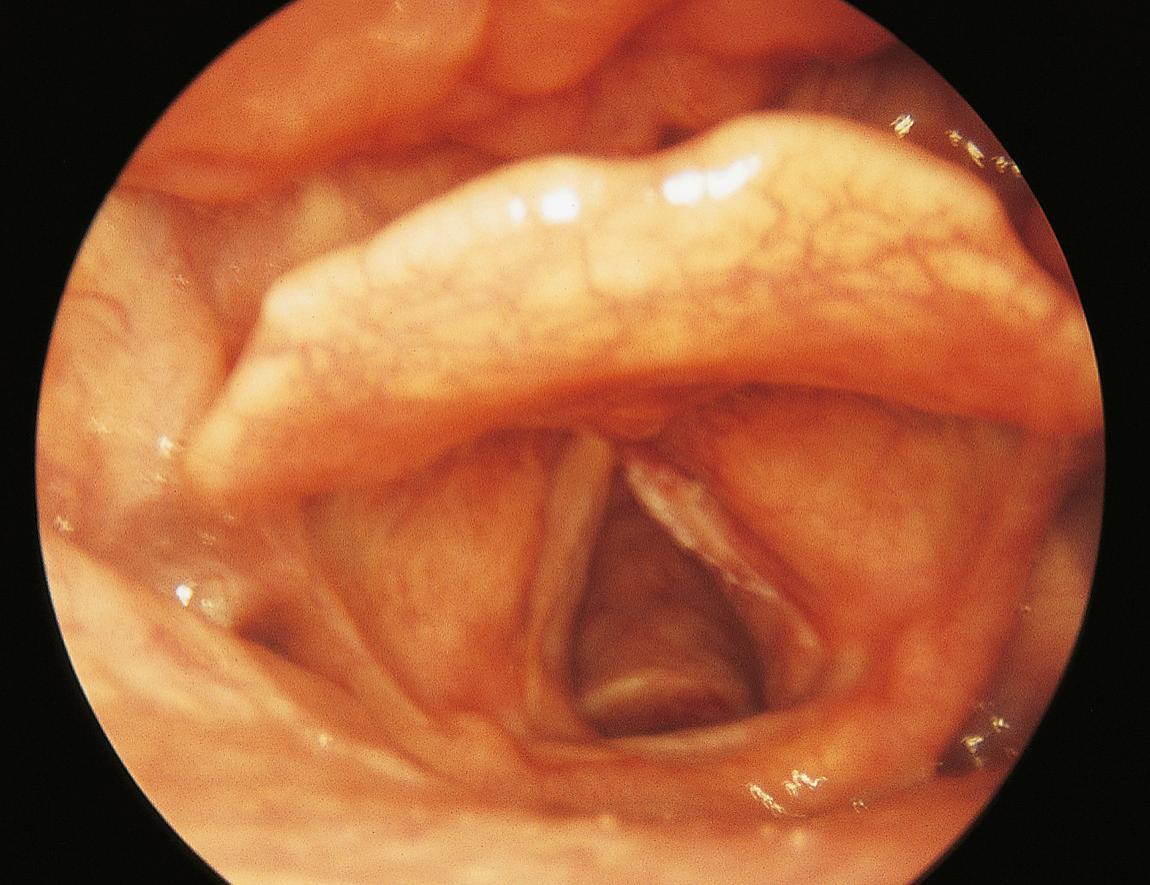
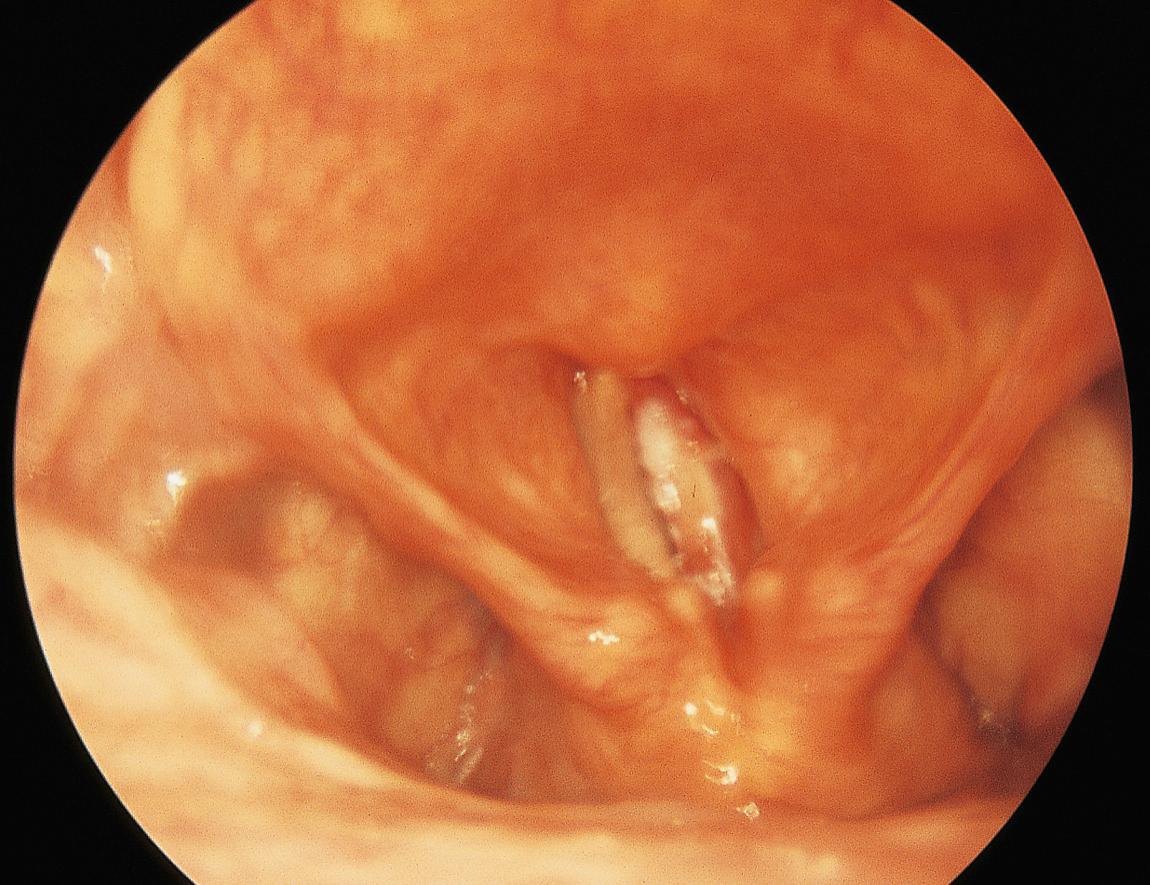
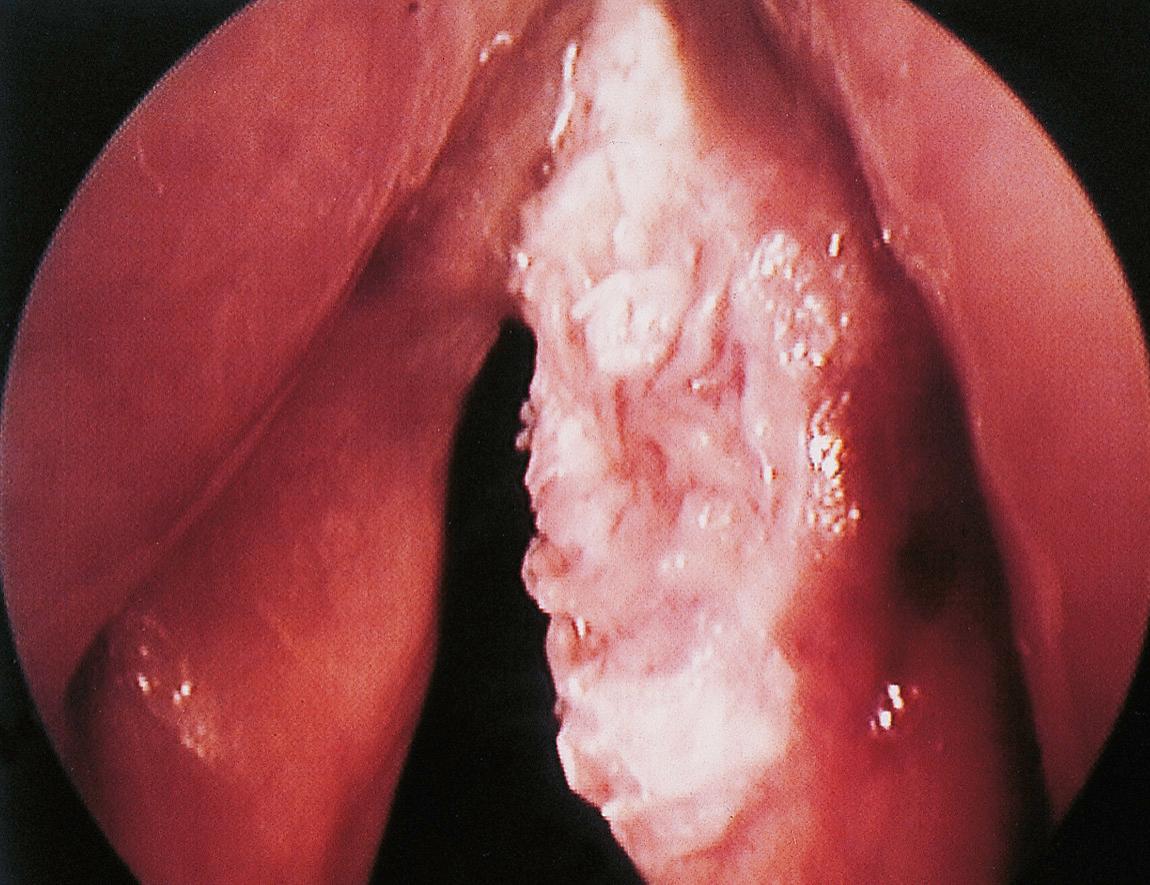
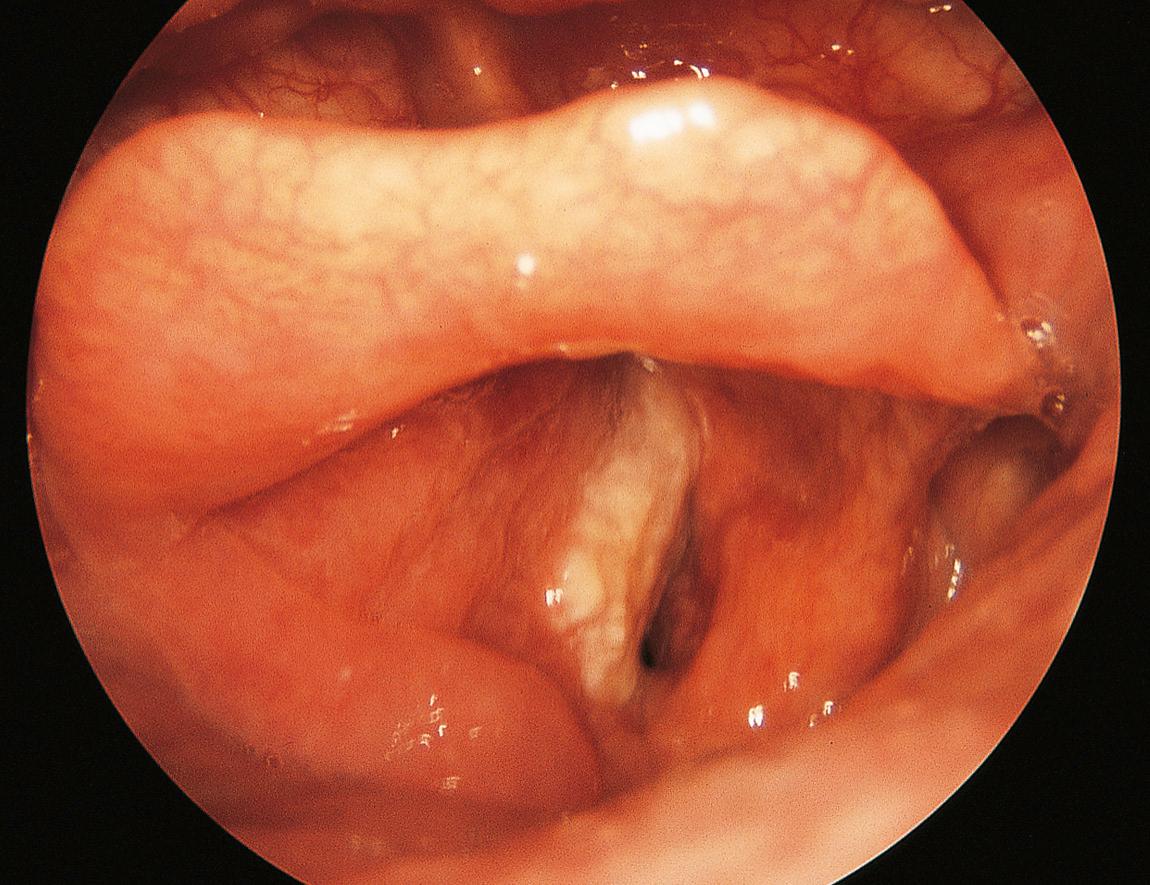
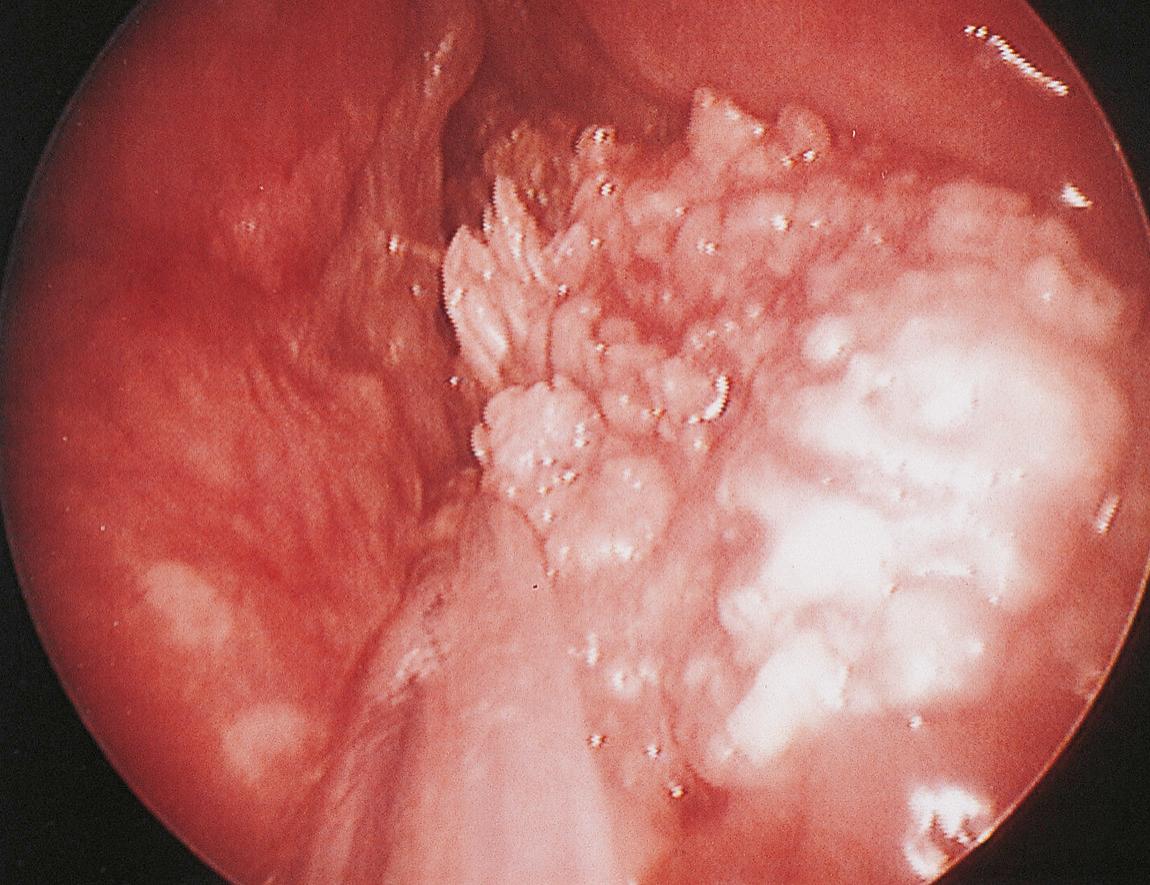
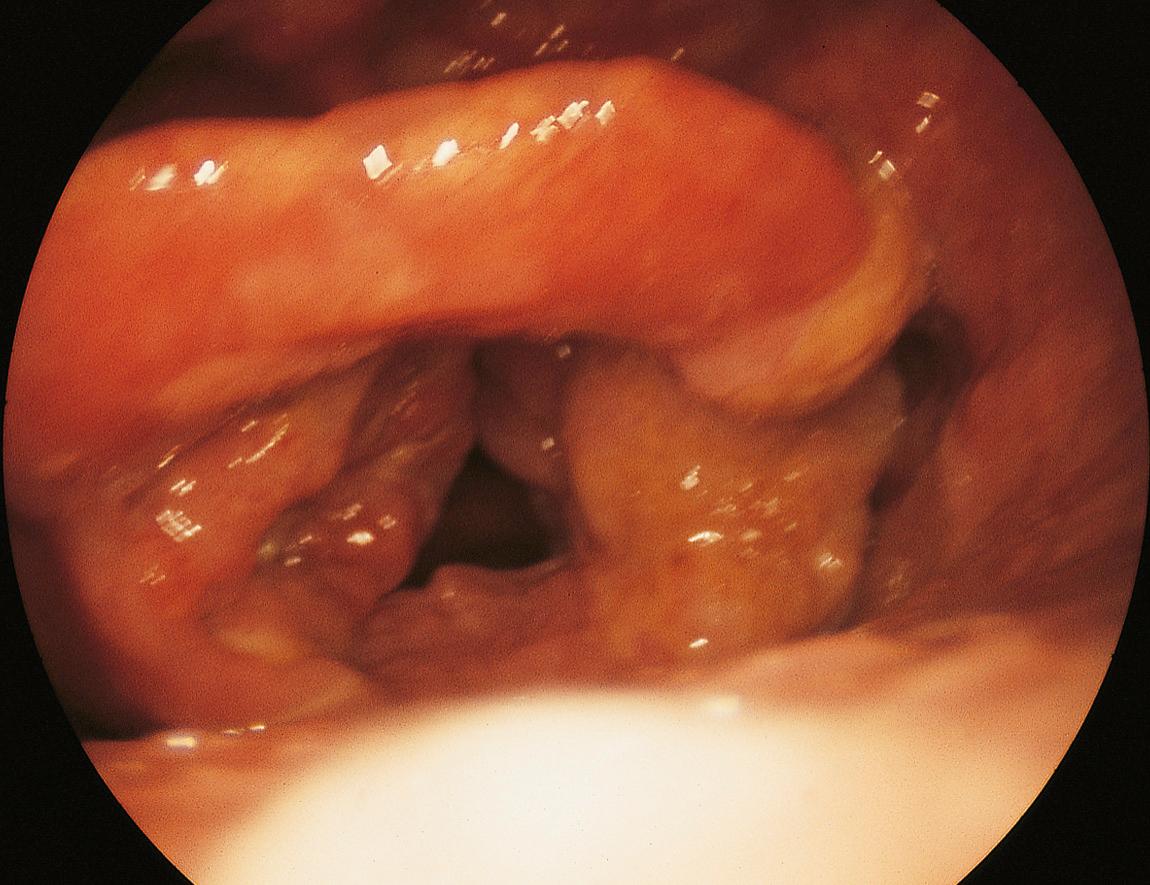
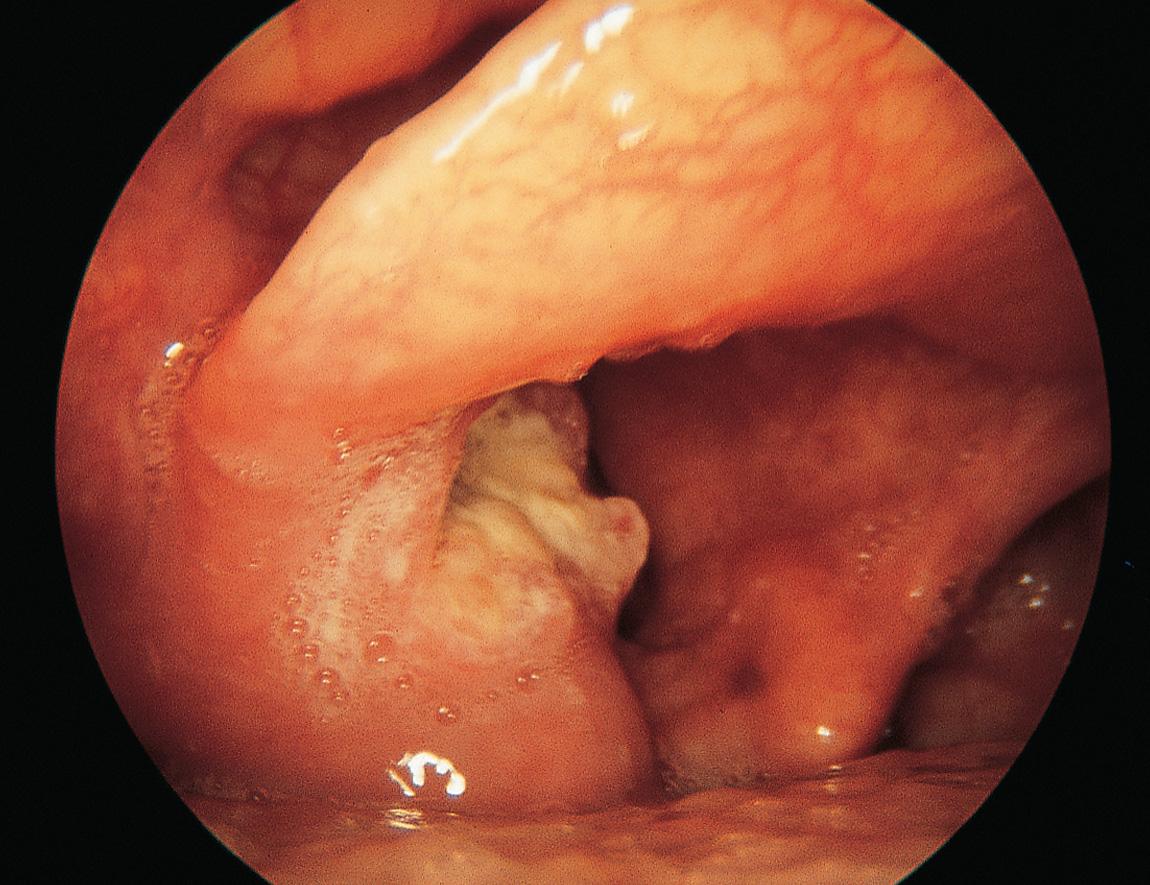
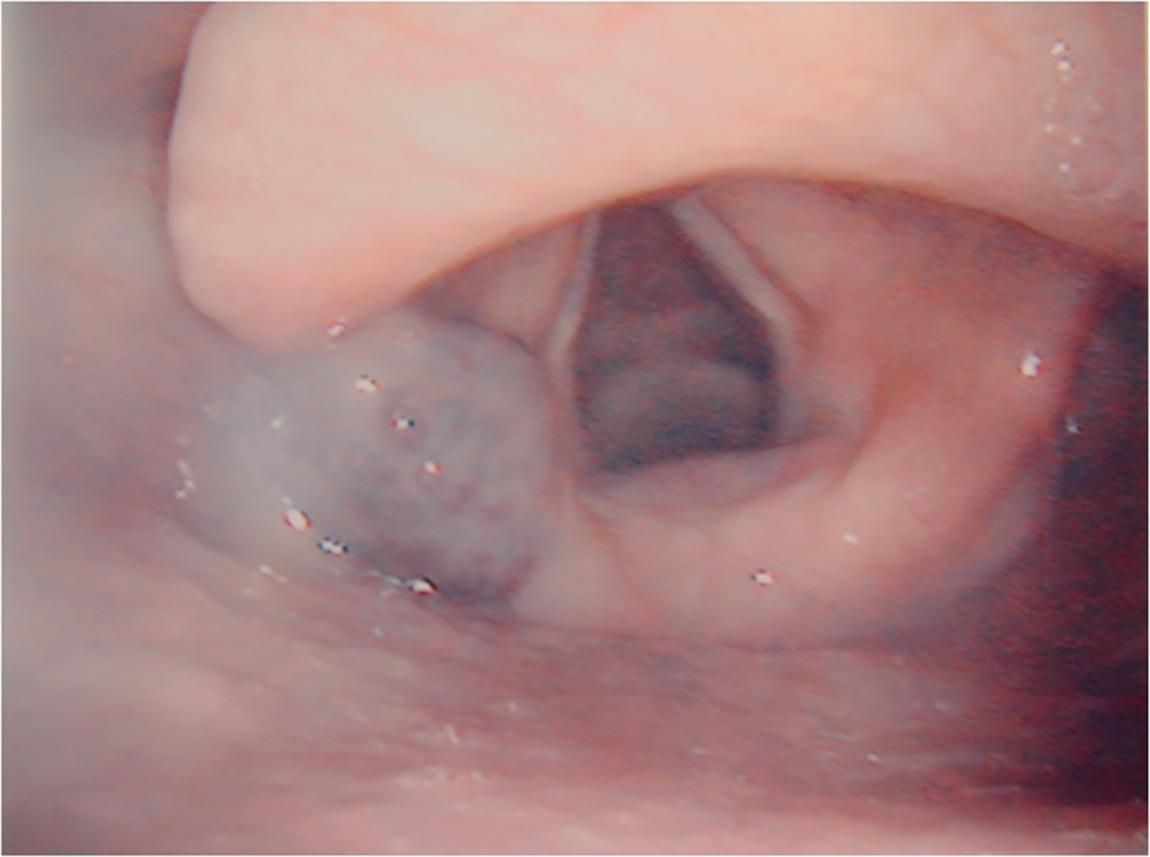
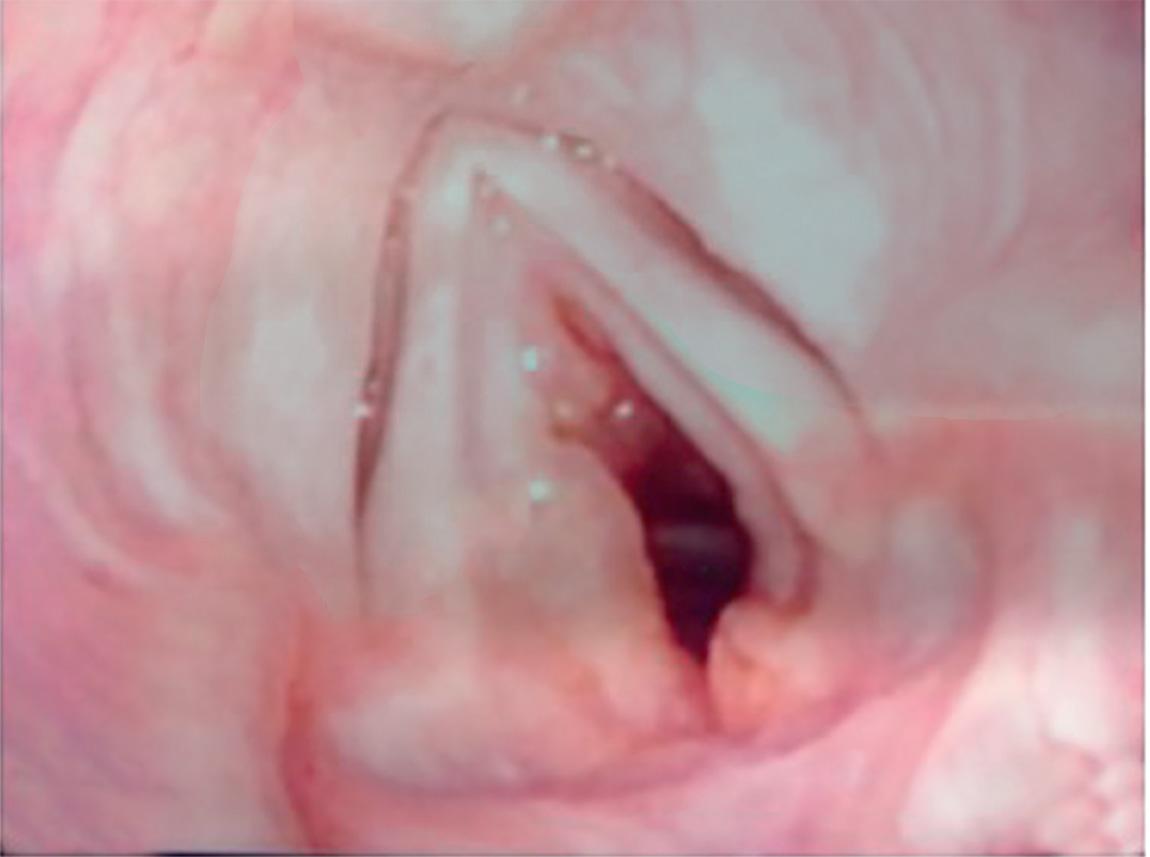
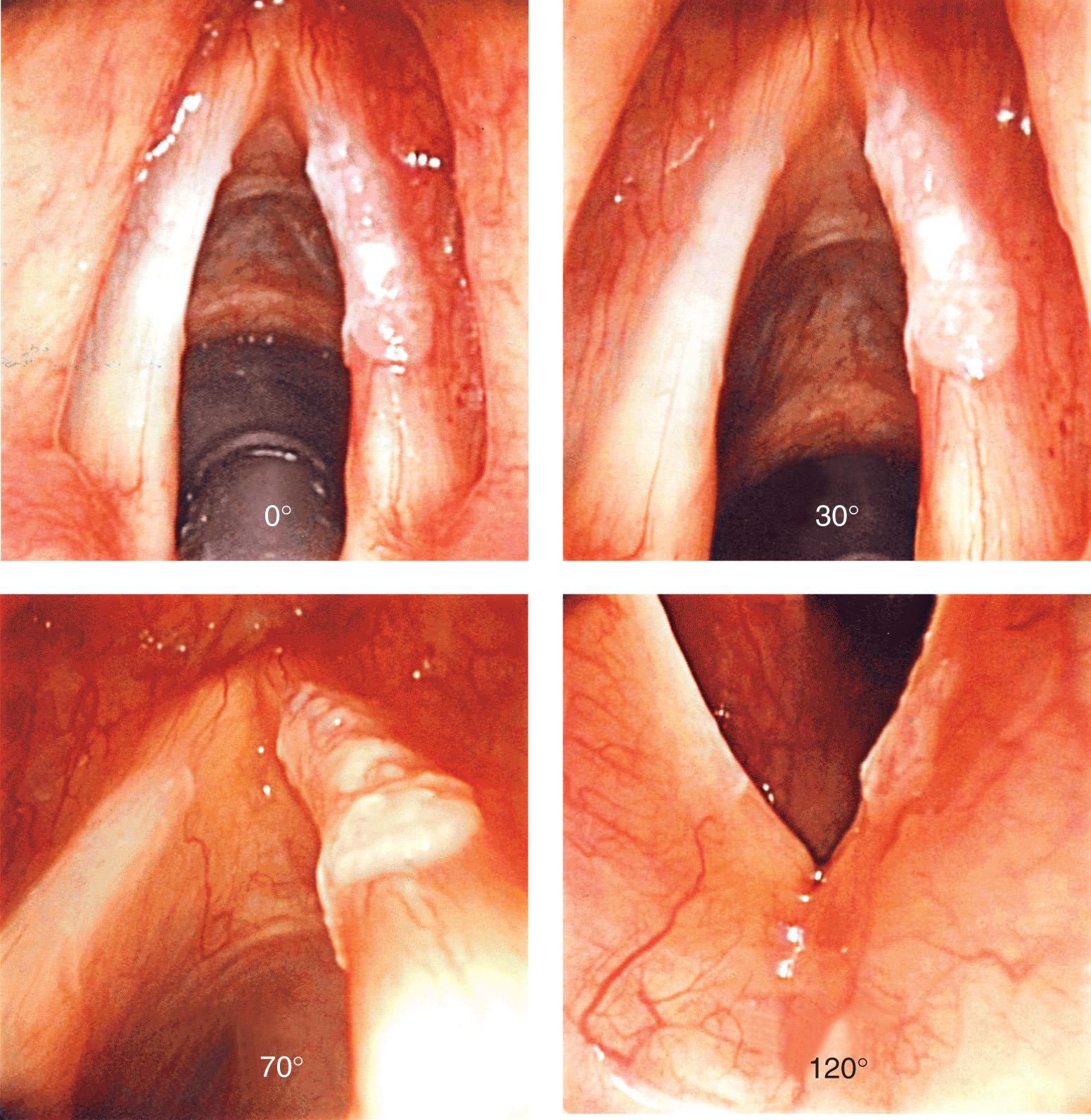
Radiographic assessment of the larynx is vitally important for delineating the extent of a tumor, particularly the third dimension, because it may influence staging and treatment selection. A computed tomography (CT) scan with intravenous contrast is usually the first and often the only radiographic study required to assess a laryngeal tumor. A CT scan with thin slices is quite accurate in assessment of laryngeal lesions, particularly with reference to tumor extension in the paraglottic space and invasion of cartilages and adjacent soft tissues. In addition, a CT scan provides the benefit of radiographic evaluation of cervical lymph nodes. Magnetic resonance imaging (MRI) of the larynx has an added ability to provide three-dimensional images in axial, coronal, and sagittal planes to further demonstrate local extension of a laryngeal lesion. This capability is of particular value in assessing the subglottic extent of the tumor.
The MRI scans of a patient who previously had undergone radiation therapy for vocal cord cancer and now presented with a recurrent tumor are shown in Figs. 10.32 through 10.34 . The axial view shows a tumor of the right vocal cord with subglottic extension partially compromising the airway. In a coronal view of the MRI scan, an exophytic lesion obstructing the subglottic airway is seen clearly. Further vivid demonstration of the subglottic tumor can be seen in the sagittal MRI view, which shows a significant obstruction produced by the recurrent tumor. The surgical specimen of the same patient who underwent a hemilaryngectomy shows the extent of subglottic disease from recurrent carcinoma of the right true vocal cord ( Fig. 10.35 ).
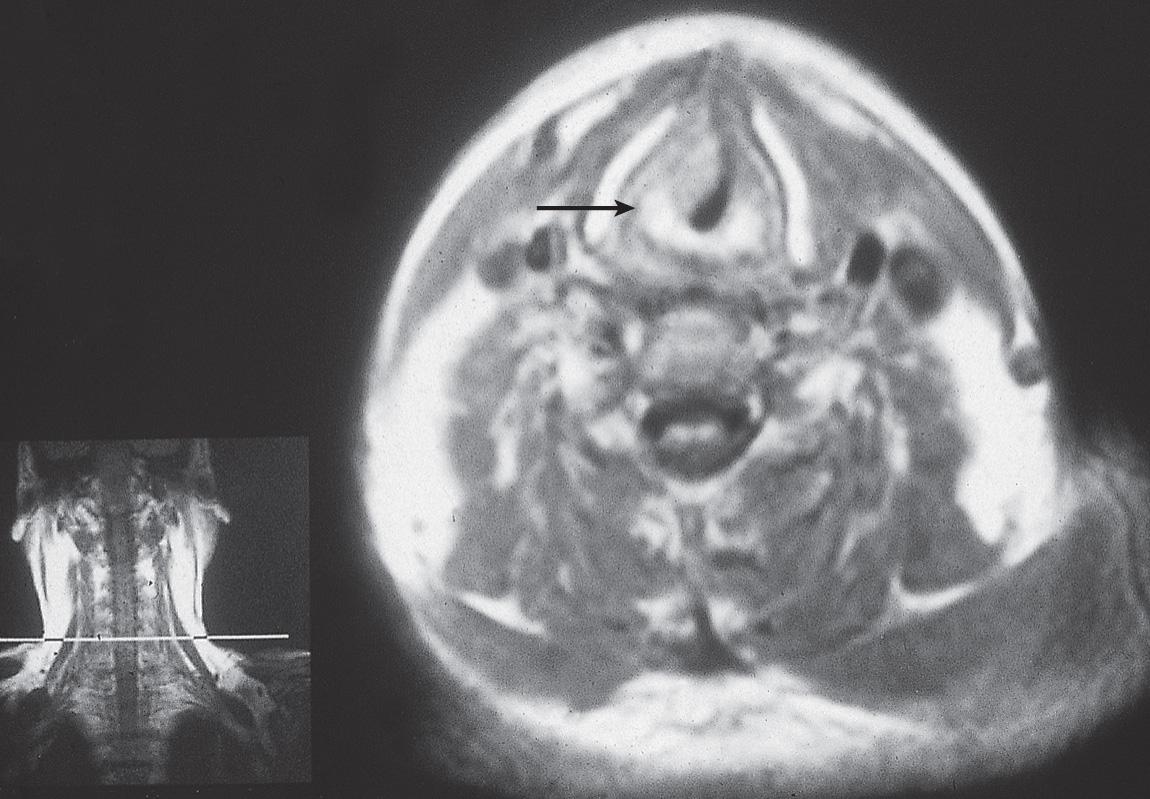
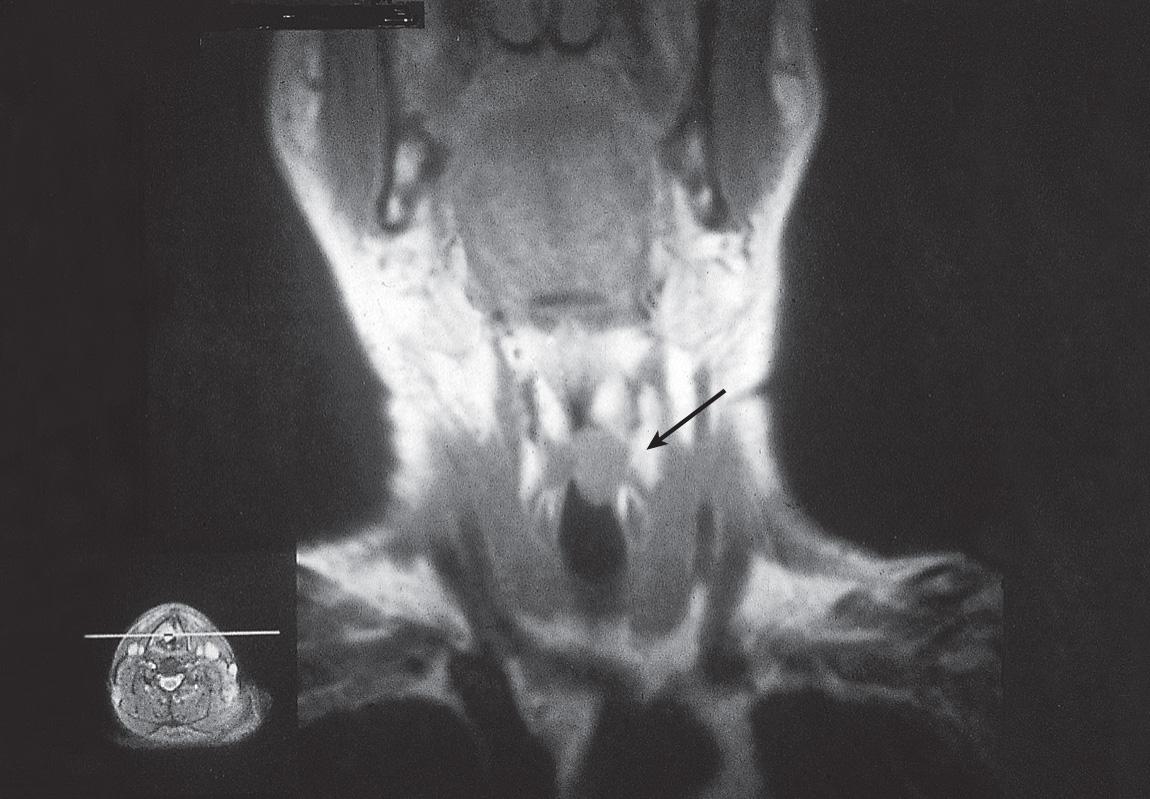
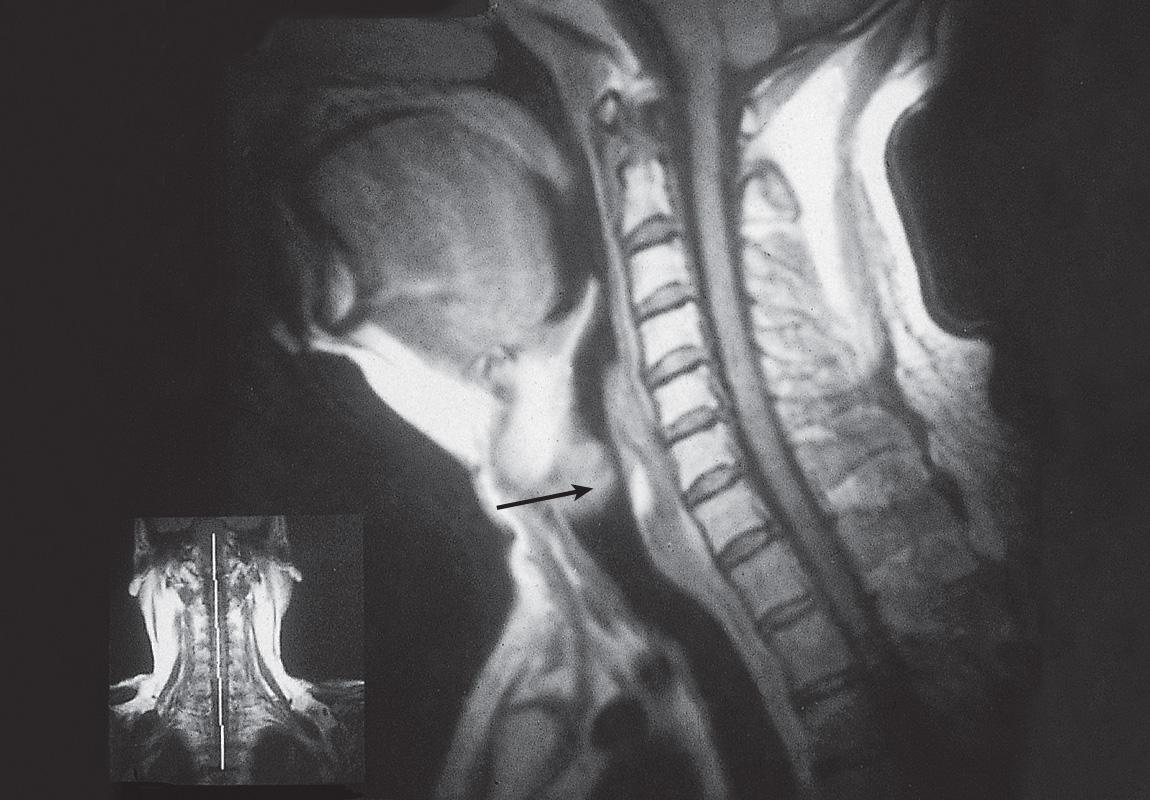
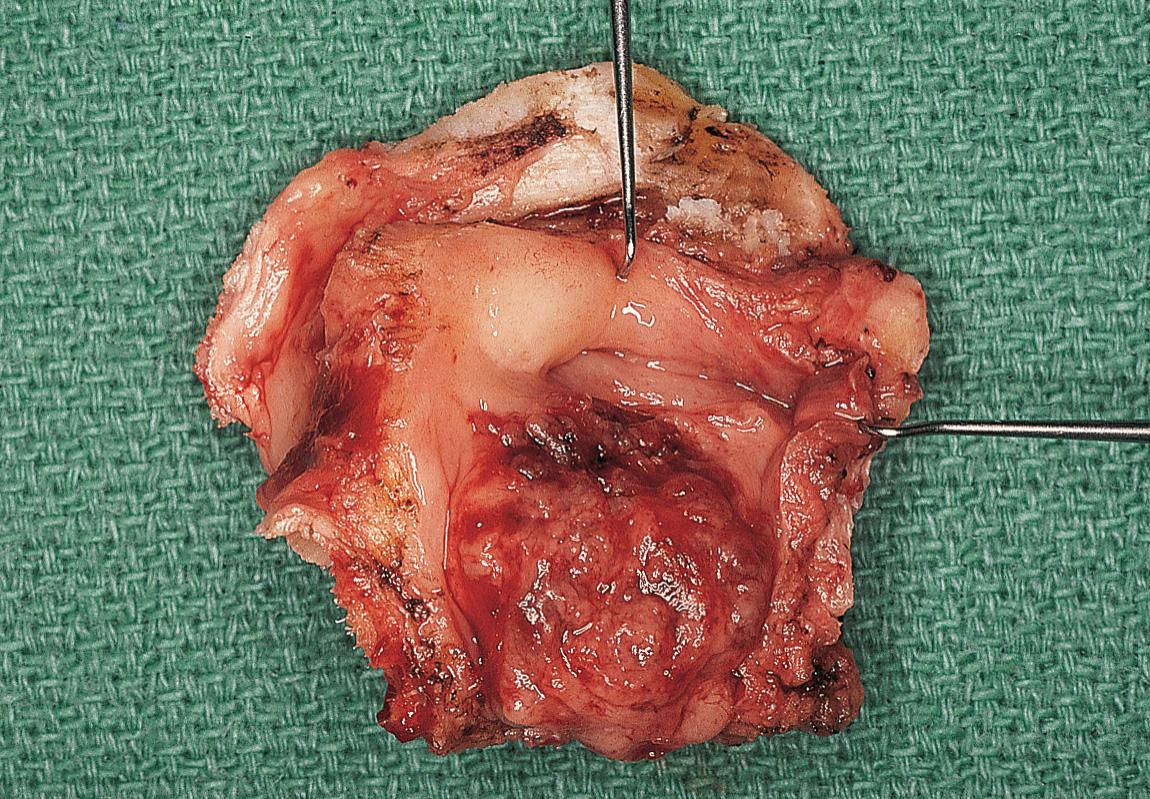
An axial view of the CT scan through the subglottic region of a patient with partial airway compromise from a chondrosarcoma of the larynx shows the tumor arising from the right side of the cricoid cartilage and projecting into the subglottic airway ( Fig. 10.36 ). The surgical specimen following total laryngectomy shows a bulky submucosal tumor arising from the right side of the subglottic region and extending across the anterior midline to the left-hand side ( Fig. 10.37 ). Note the degree of airway compromise due to the bulk of the lesion on both sides of the midline.
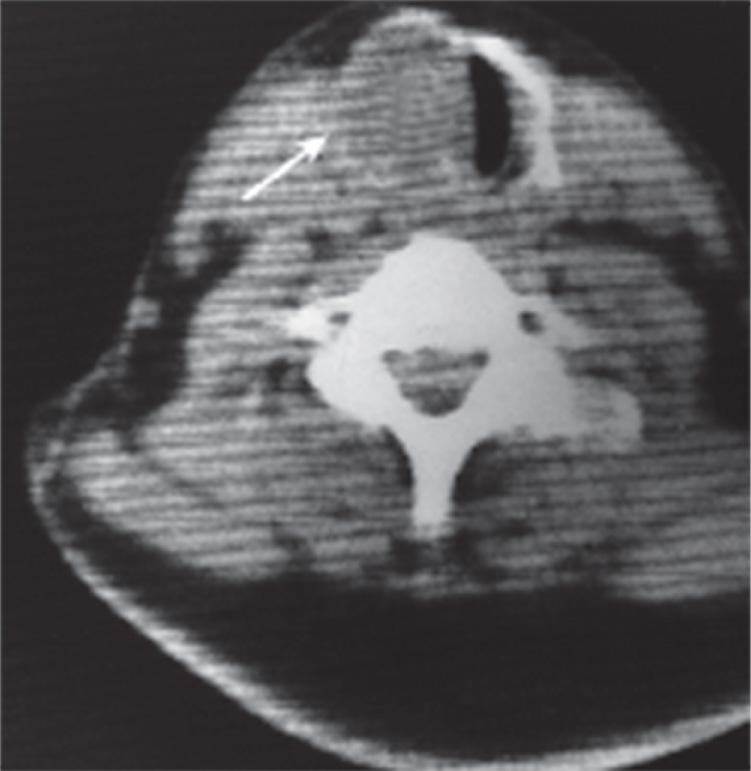
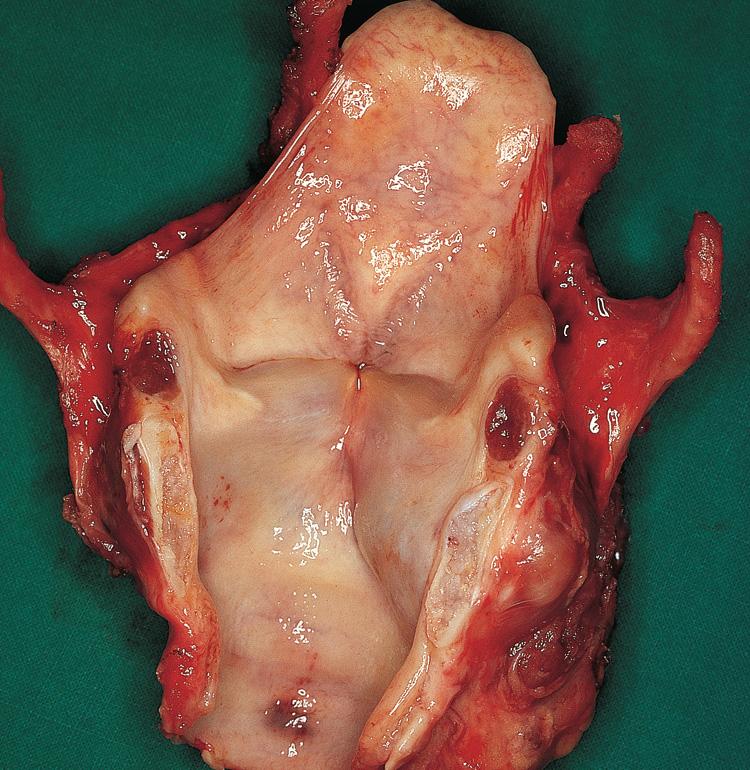
Another patient with a chondrosarcoma of the cricoid cartilage presented with significant respiratory obstruction. A CT scan in the axial view without contrast shows a cartilaginous tumor arising from the cricoid cartilage and presenting anteriorly, causing compromise of the airway ( Fig. 10.38 ). An endoscopic view of the same patient under general anesthesia shows a bulky submucosal multilobulated tumor arising from the cricoid cartilage and the region of the cricoarytenoid joint on the left-hand side with compromise of the airway ( Fig. 10.39 ).
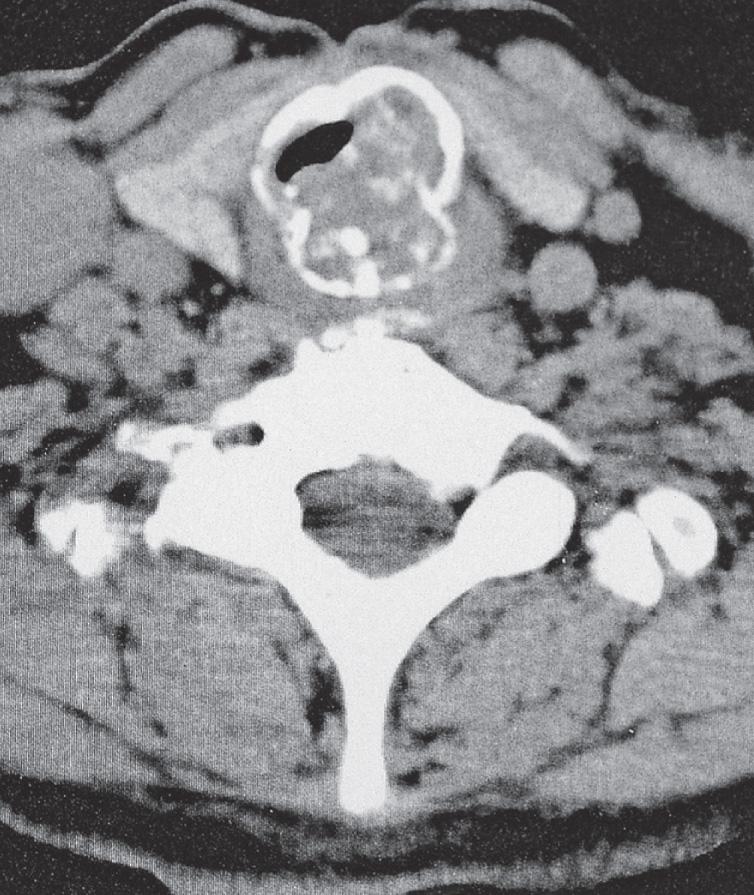
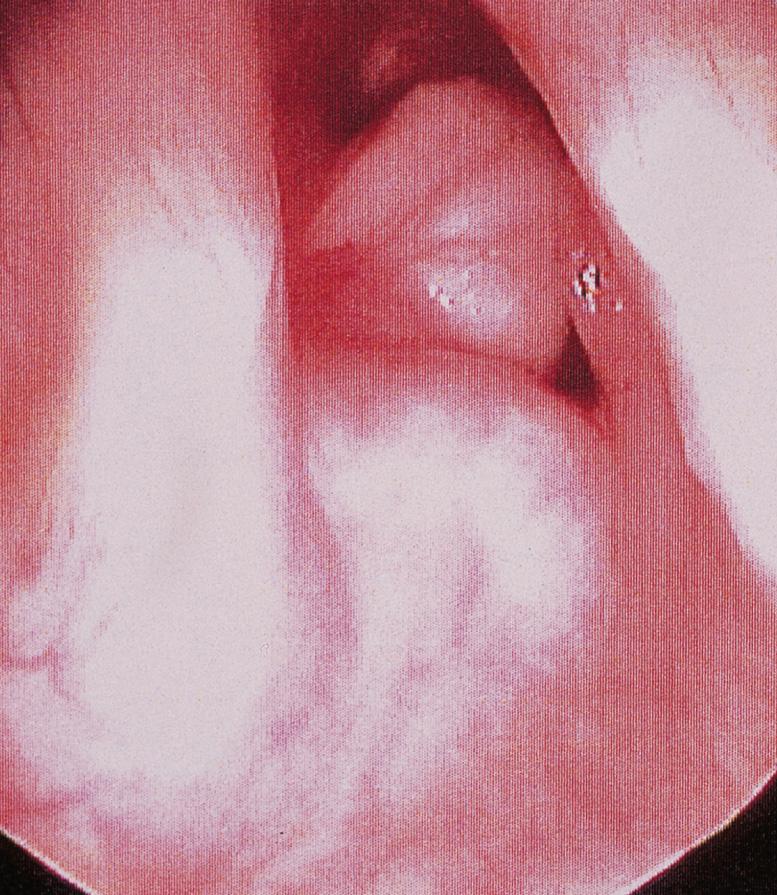
Occasionally a CT scan will detect an unsuspected second primary tumor or, more importantly, enlarged cervical lymph nodes that are not palpable clinically. An example of this finding is shown in a patient whose telescopic view of the larynx is shown in Fig. 10.40 . A primary tumor is seen arising from the left aryepiglottic fold, and both pyriform sinuses open well and appear to be clear. However, the same patient's CT scan at the level of the thyrohyoid membrane shows the presence of one lesion on the aryepiglottic fold with what appears to be a second lesion on the lateral wall of the pyriform sinus ( Fig. 10.41 ). The surgical specimen of the same patient after a supraglottic partial laryngopharyngectomy shows two separate primary lesions: one on the aryepiglottic fold and a second lesion on the lateral wall of the pyriform sinus that clinically was not appreciated ( Fig. 10.42 ). Thus CT scans of the larynx are recommended for initial assessment of laryngeal cancer, regardless of the treatment plan for the tumor. An MRI scan of another patient with a submucosal lesion of the infrahyoid portion of the laryngeal surface of the epiglottis is shown in Fig. 10.43 . Note the extension of the tumor into the preepiglottic space and its cephalocaudad extension, as well as the posterior projection of the tumor, which is causing compromise of the airway. An axial view of the MRI scan of the same patient shown in Fig. 10.44 demonstrates the extension of the tumor into the preepiglottic space at the level of the superior border of the thyroid cartilage. An endoscopic view of this patient under general anesthesia shows the multilobulated submucosal tumor of the laryngeal surface of the epiglottis ( Fig. 10.45 ). A biopsy of this tumor confirmed that it was an adenoid cystic carcinoma.
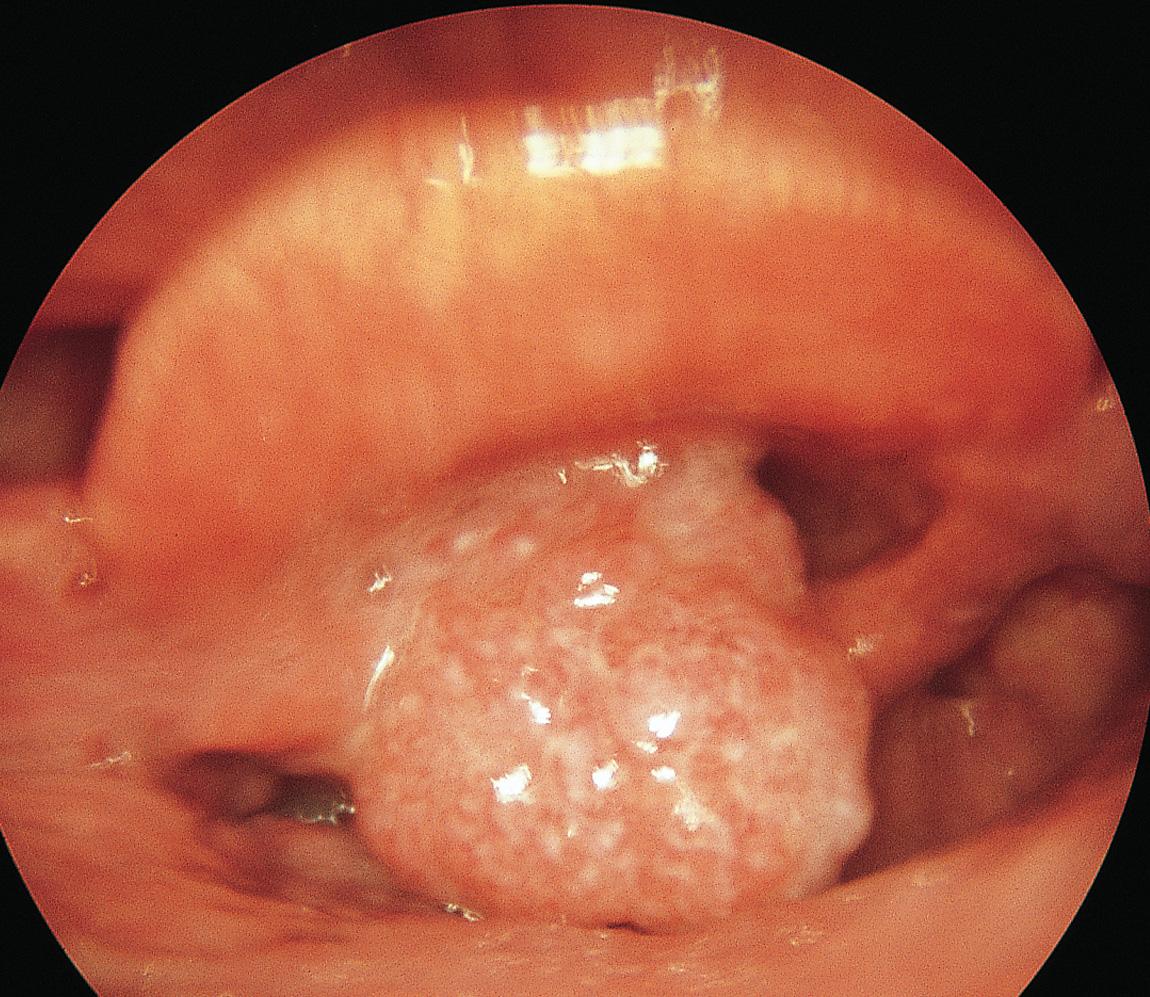
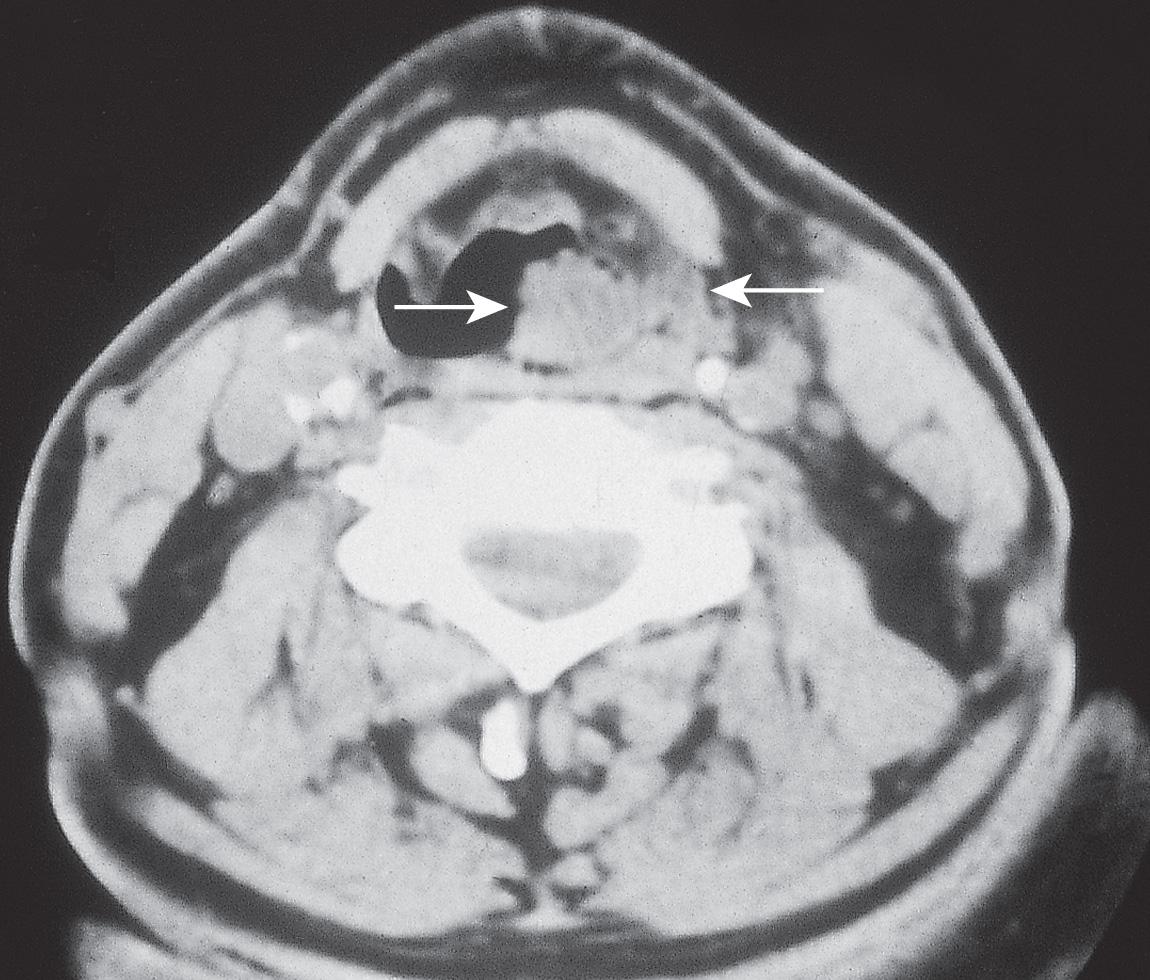
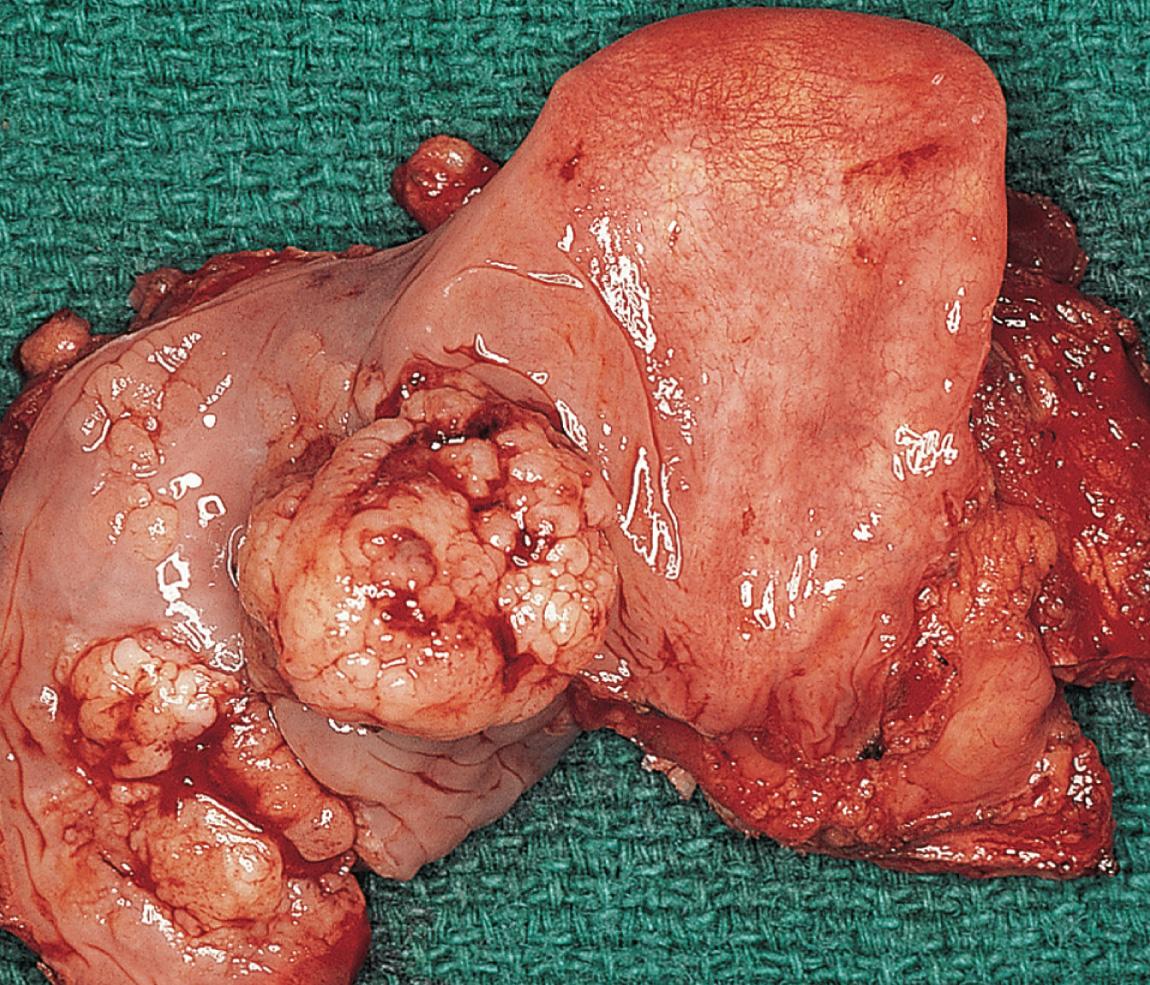
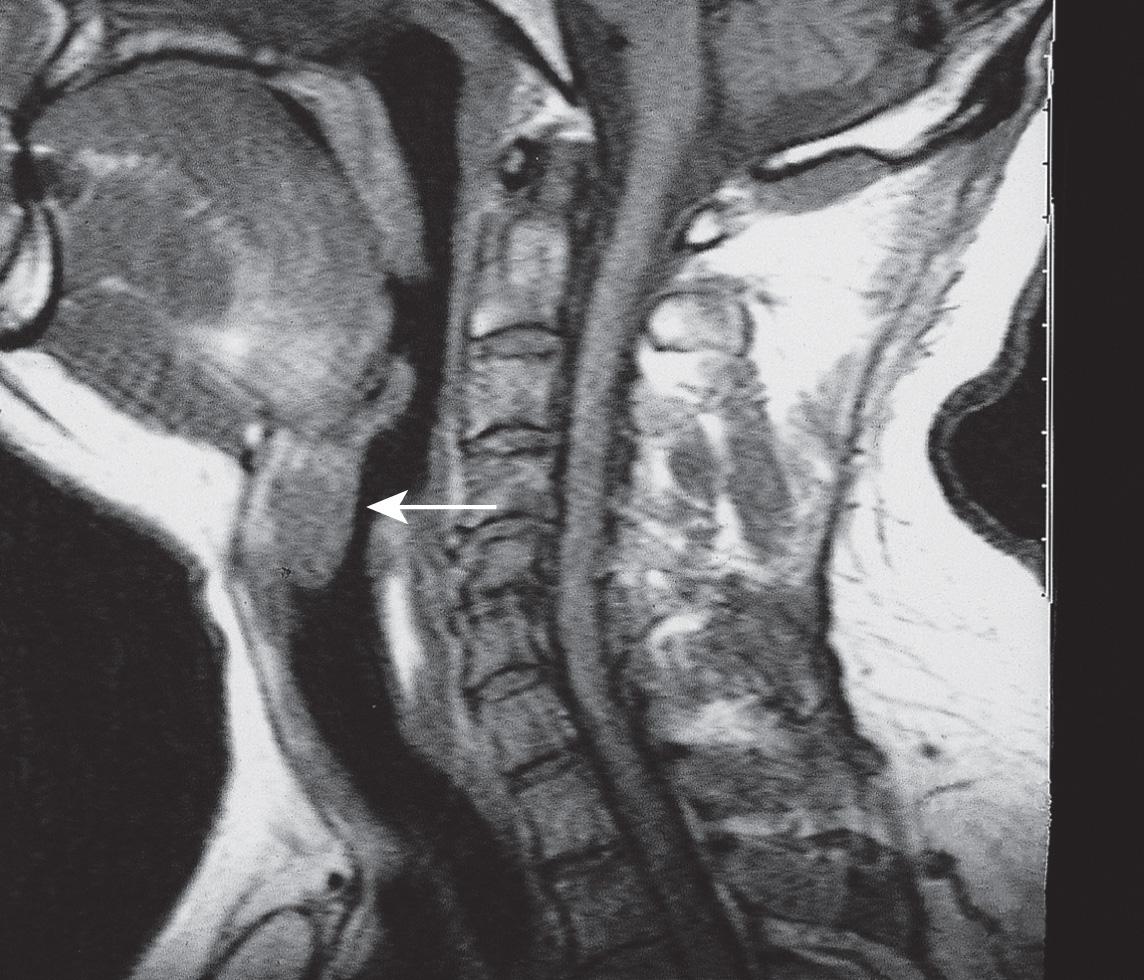
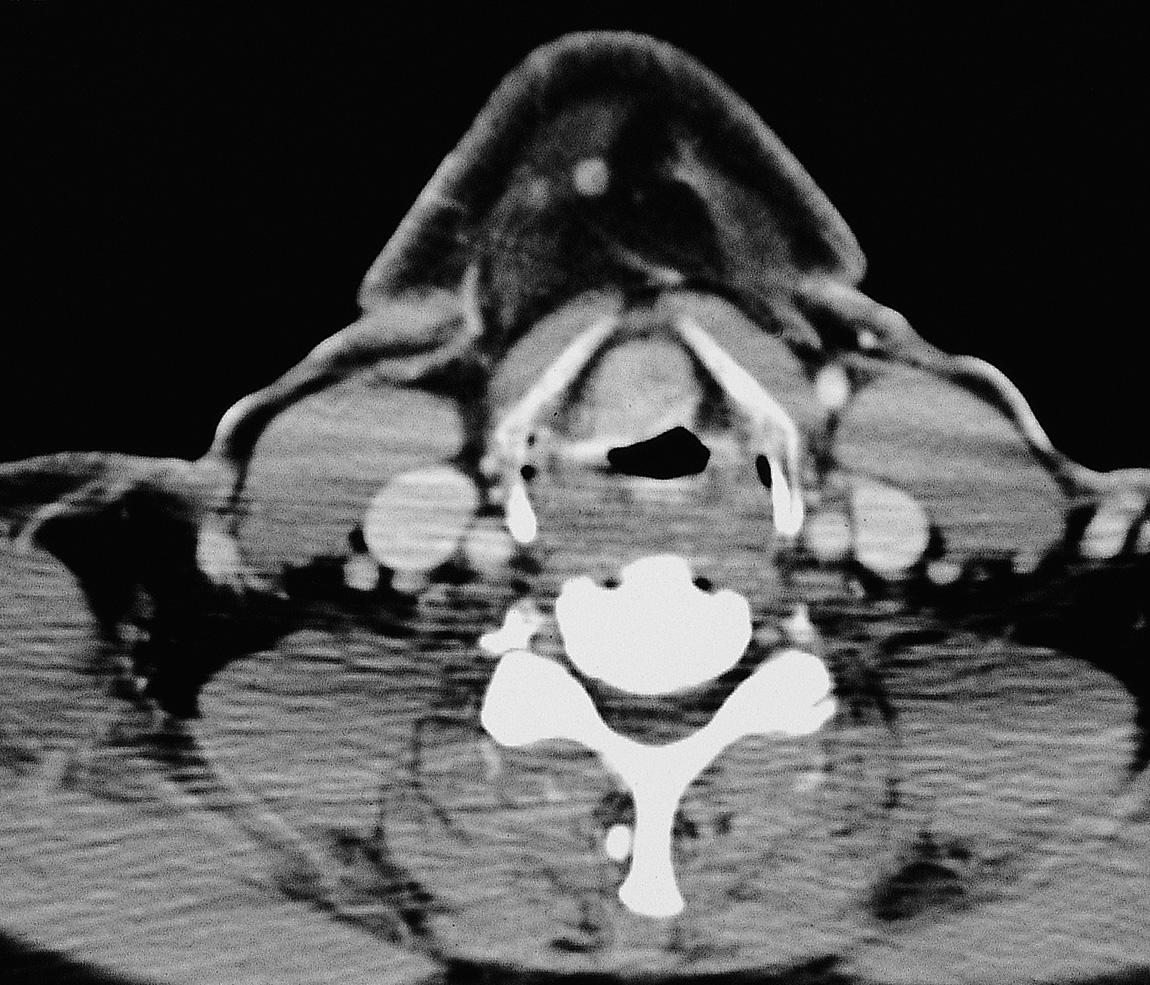
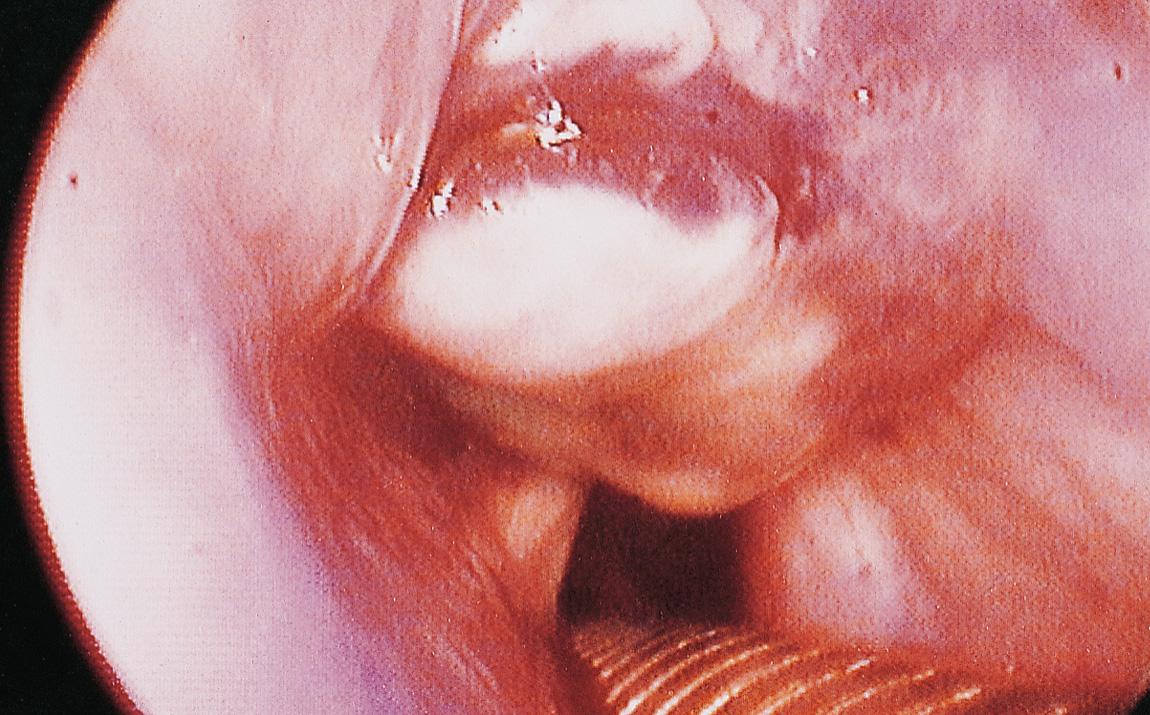
Another patient with a submucosal lesion of the suprahyoid portion of the laryngeal surface of the epiglottis is shown in Fig. 10.46 . This sagittal view of the MRI shows a submucosal lesion of limited extent involving only the suprahyoid portion of the epiglottis without any extension to the preepiglottic space. Endoscopic examination of the patient shows the lesion to be a smooth submucosal lesion involving the laryngeal surface of the epiglottis ( Fig. 10.47 ). This lesion was adequately resected endoscopically and proved to be a schwannoma of the epiglottis.
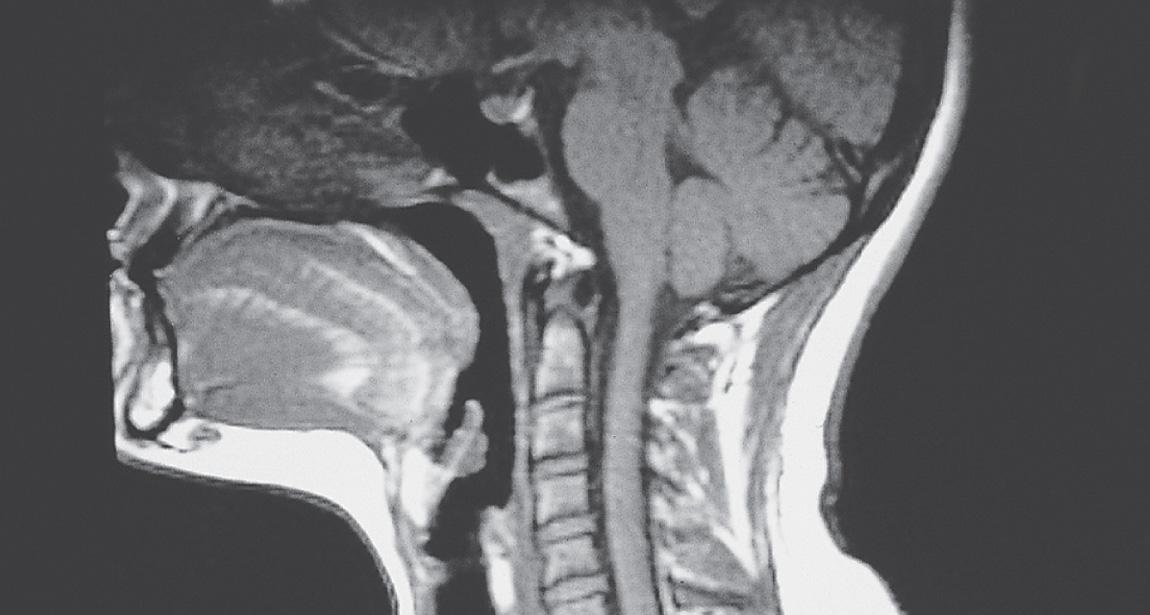
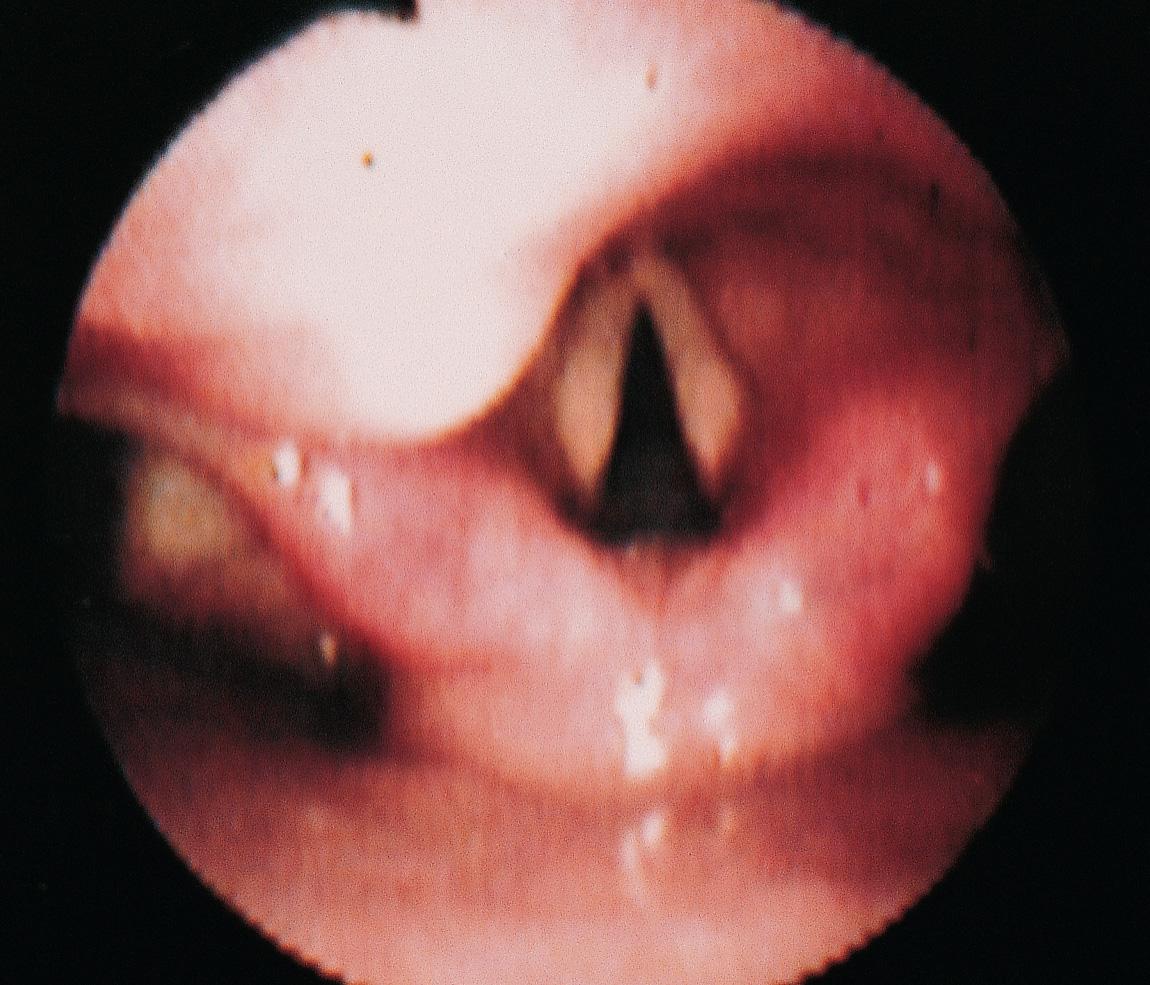
Fig. 10.48 shows an axial CT scan of a patient who previously had undergone endoscopic excision followed by external radiotherapy for a left glottic carcinoma. The radiologic extent of recurrent tumor in the left subglottic region was indicative of the actual extent of tumor found in the total laryngectomy specimen ( Fig. 10.49 ).
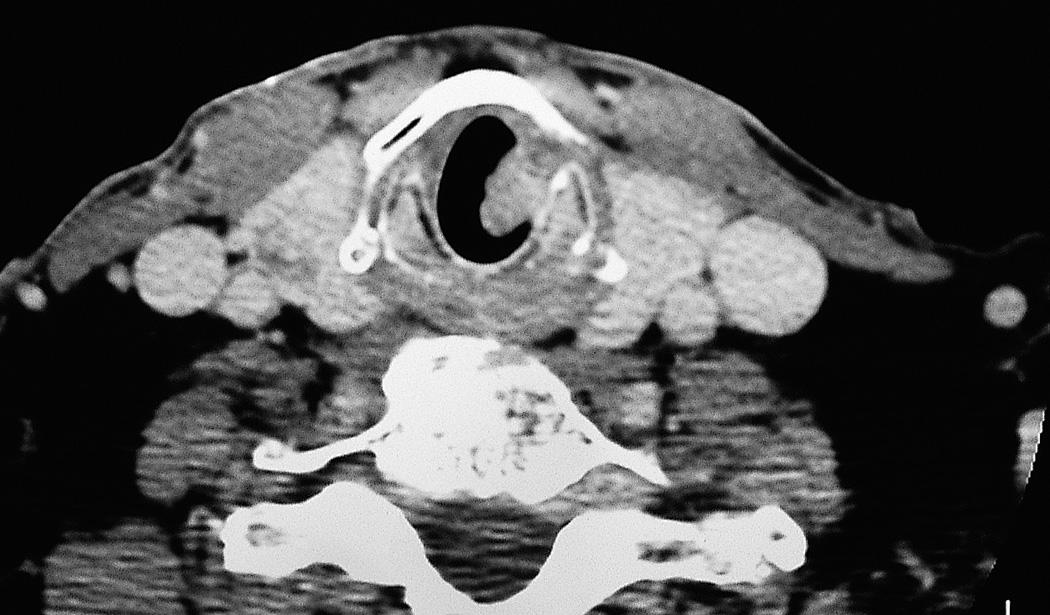
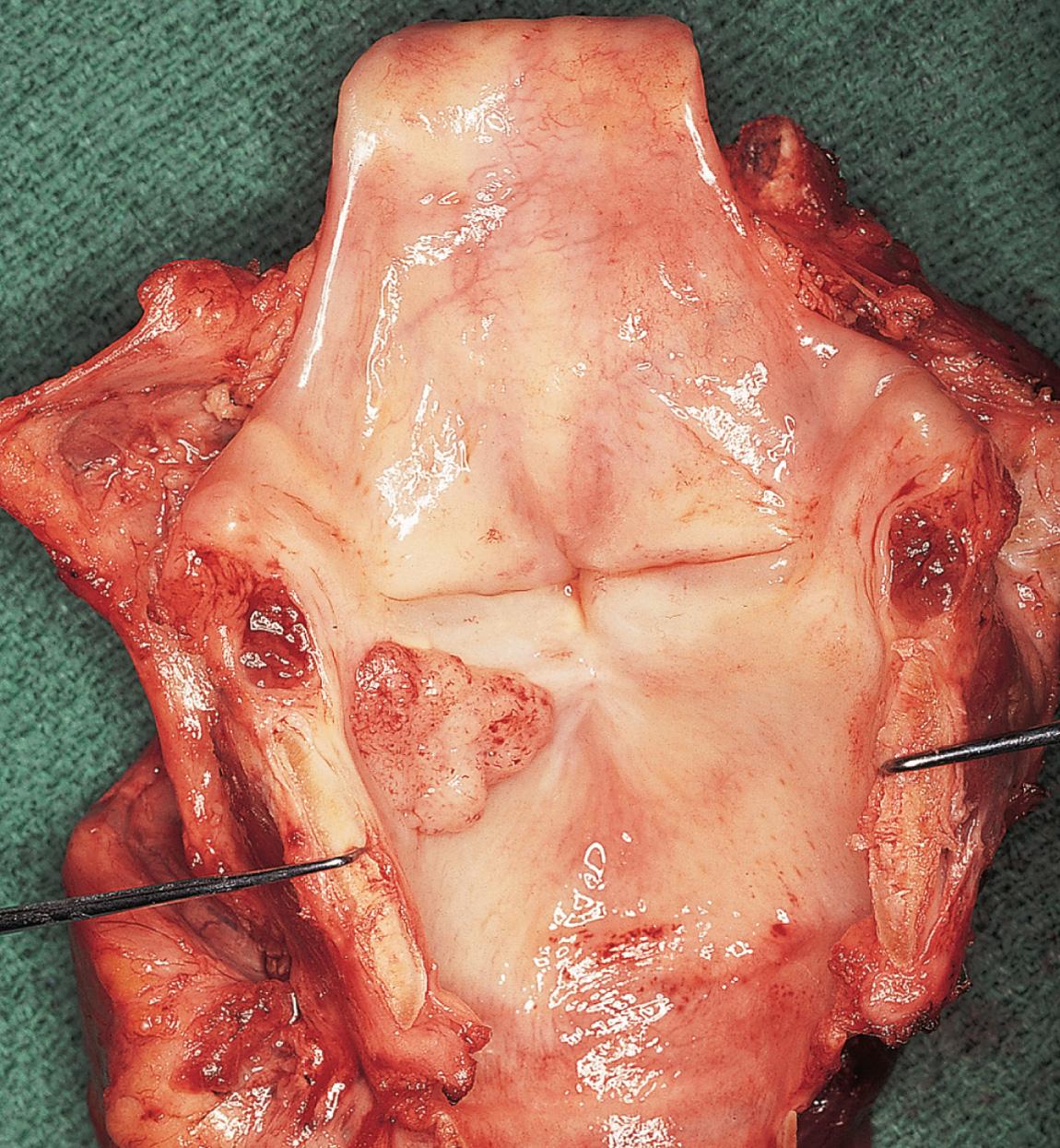
Both CT and MRI scans have the added advantage of providing assessment of regional lymphatics of the neck, particularly for patients in whom regional lymph nodes are not palpable clinically.
The primary goal for the treatment of cancer of the larynx is clearly control of the disease. In considering treatment approaches, preservation of speech and swallowing and avoidance of a tracheostome are desirable secondary goals. Traditionally the treatment of laryngeal carcinoma has been either radiation therapy or surgery or a combination of both. In the past, early-stage cancers were treated with external radiation therapy, keeping surgery in reserve for salvage. On the other hand, advanced cancers of the supraglottis and glottic cancers were treated with a total laryngectomy, followed by postoperative radiation therapy. However, over the course of the past 25 years, advances in technology and instrumentation have offered another option for initial treatment of early-stage tumors. Similarly, experience with larynx preservation with chemoradiation therapy has accumulated, with data, clearly defining the indications for and the efficacy with concurrent or sequential chemoradiotherapy. Thus this approach has now become the standard of care for most advanced-stage tumors. The treatment of laryngeal cancer continues to evolve with the availability of newer modalities such as biological agents, transoral laser microsurgery (TOLM), and transoral robotic surgery (TORS) ( Fig. 10.50 ).
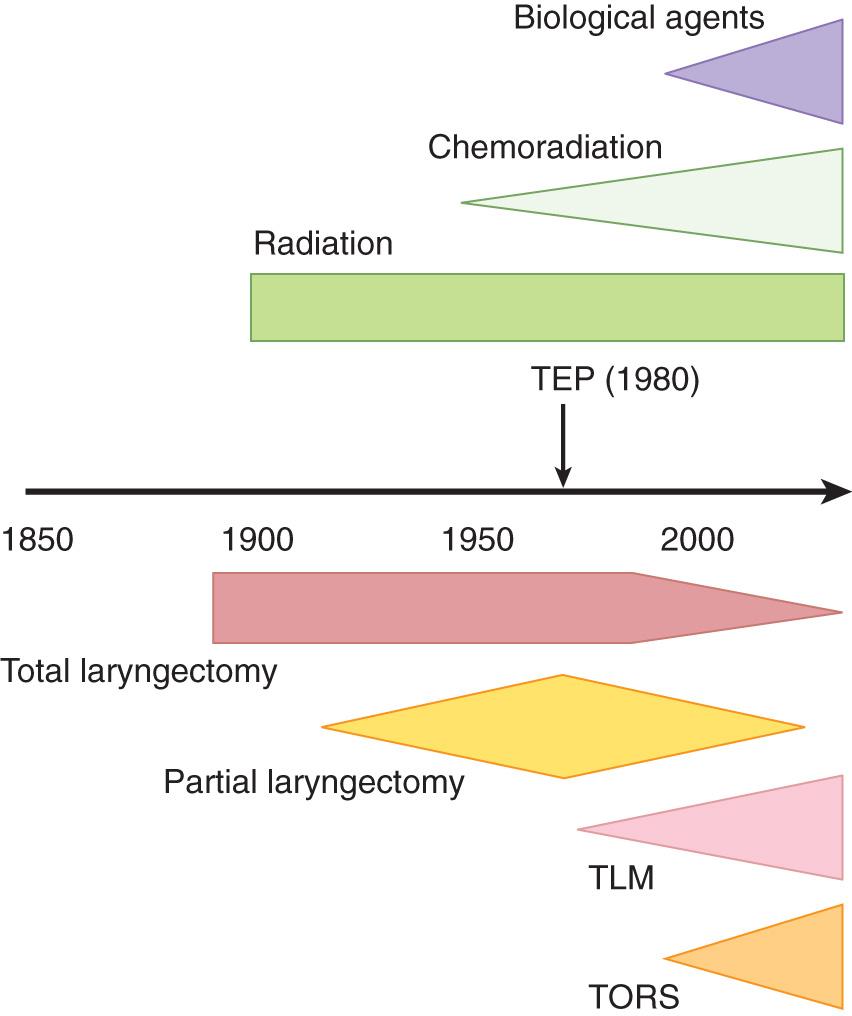
Surgical and nonsurgical approaches have shown equivalent efficacy in survival outcomes for treatment of laryngeal cancer. However, the functional sequelae of each treatment approach must be considered in selecting the most appropriate treatment program for the individual patient. Treatment selection in patients with laryngeal cancers is also influenced by tumor, patient, and physician factors.
Expertise and knowledge on the part of the physician and the treatment team about the biological behavior of laryngeal cancer and the anticipated response to therapy influence treatment selection. Technical expertise and access to state-of-the-art equipment are equally important factors influencing treatment selection. For early-stage tumors, endoscopic laser resection should be offered to patients if the equipment, and expertise and experience of the surgical team are available. Similarly, effective tumor control and minimization of sequelae of therapy require expertise in contemporary radiation techniques such as intensity-modulated radiotherapy and in selected cases unilateral laryngeal RT. Coordinated multidisciplinary management teams are essential for the successful outcome of chemoradiation therapy for organ-preserving treatment of advanced laryngeal carcinoma. Additional support from speech and swallowing therapists, nutritionists, psychiatrists, and social services, along with expert nursing care, are equally important. Therefore such treatment programs are best delivered at tertiary care centers.
In selecting treatment for an individual patient, several anatomic, physiologic, geographic, and vocational factors play a role. Patients with significant medical comorbidity and/or poor pulmonary reserve are not candidates for conservation laryngeal surgery, even if it is done endoscopically. Similarly, patients with unfavorable anatomy for endoscopic exposure of the larynx (e.g., a short neck, cervical osteoarthritis, trismus, or prominent upper incisor teeth) may not be candidates for transoral laser surgery. Radiation therapy may not be a viable option for patients who are not able to travel to the treatment facility. This factor is particularly applicable to persons with very early vocal cord cancers for whom endoscopic laser excision provides equally good disease control and an acceptable quality of voice compared with external radiation therapy, which takes approximately 6 to 7 weeks to complete. If the quality of voice is a critically important issue for the patient, then radiotherapy may be chosen as the initial treatment. On the other hand, patients who are unable to receive or comply with radiotherapy may prefer endoscopic laser resection, even if the quality of voice may be inferior.
The most important parameters influencing treatment selection are the location and extent of the primary tumor and the status of the regional lymph nodes. In general, carcinomas of the supraglottic larynx have a higher risk of regional nodal metastases compared with glottic carcinomas, and these are often bilateral. Management of the neck thus becomes an integral part of the overall treatment plan for supraglottic cancer. Treatment of the ipsilateral neck with negative clinical findings is indicated for well-lateralized supraglottic cancers, and both sides need to be addressed when tumors approach or involve the midline. Early-stage supraglottic cancers can be treated effectively with either external radiation therapy or endoscopic resection. Exophytic tumors in particular are highly radioresponsive. The advantage of radiation therapy is that it can treat the regional lymph nodes electively along with the primary tumor. On the other hand, if the primary tumor is treated surgically, unilateral or bilateral elective dissection of first-echelon lymph nodes is recommended in most patients. The morbidity of elective neck dissection is minimal. However, if metastatic disease is confirmed, then postoperative radiation therapy may be indicated and is associated with significantly increased morbidity in this setting.
Early-stage carcinomas of the glottic larynx can be treated effectively by single-modality treatment consisting of either endoscopic resection or radiotherapy. Endoscopic resection is ideally suited for most T1 lesions that are confined to the mucosa of one vocal cord without involvement of the anterior commissure. Bilateral involvement (T1b) generally is not considered suitable for endoscopic resection. Although endoscopic resection is expeditious and cost-effective, the quality of voice may not be as good as with radiotherapy. On the other hand, radiation therapy is ideally suited for lesions with bilateral involvement, involvement of the anterior commissure, and infiltration into the underlying vocalis muscle. Vocal cord carcinomas staged as T2 represent a spectrum of diseases with diverse behavior. Tumors that are staged T2B by virtue of reduced vocal cord mobility are better treated with radiation therapy, whereas endoscopic laser resection may be an option for exophytic tumors (T2A) that do not compromise vocal cord function. Open voice-preserving partial laryngeal surgery, which once was popular for early-staged laryngeal carcinoma, is now considered only in select circumstances. Patients suitable for endoscopic resection avoid an open operation and the tracheostomy that traditionally is required after an open partial laryngectomy. At present, an open partial laryngectomy for supraglottic or glottic cancer is considered in patients not suitable for endoscopic resection and for those with persistent or recurrent tumors after previous radiation therapy. Involvement of the regional lymph nodes is exceedingly rare in early-stage glottic carcinoma. Therefore elective treatment of regional lymph nodes is not indicated.
More advanced lesions of the larynx (T3 and T4a) require multidisciplinary treatment. Initial surgery often requires a total laryngectomy by virtue of tumor extent or the anticipated functional status of the residual organ after an extended partial laryngectomy. On the other hand, radiation therapy alone offers lower local control rates, requiring a total laryngectomy for salvage in a large proportion of patients. Although a total laryngectomy followed by postoperative radiation therapy was considered the standard of care, the posttreatment quality of life of patients was significantly influenced by the loss of the larynx. During the course of the past 25 years, the management of advanced laryngeal carcinomas has been profoundly influenced by results from organ preservation trials. Results of a prospective randomized trial from the Department of Veterans Affairs Laryngeal Cancer Study Group (VA Trial), conducted in the 1980s, first demonstrated that the use of neoadjuvant chemotherapy followed by radiation therapy achieved survival outcomes similar to those of a total laryngectomy followed by postoperative radiation therapy but with the advantage of preserving the larynx in two-thirds of patients. A subsequent radiation therapy oncology group head and neck intergroup study (RTOG 91-11) showed that concomitant chemoradiation treatment was superior to sequential treatment for locoregional control and larynx preservation. Therefore concomitant chemoradiation has become the standard of care for most patients with advanced laryngeal carcinomas. More recently, further intensification in treatment with multiple drugs and the addition of neoadjuvant chemotherapy to concomitant chemoradiation therapy has been suggested to enhance outcomes. However, the latter two treatment strategies are accompanied by increased acute toxicity and long-term sequelae in a significant number of patients. Further research is required to develop an optimal multimodal regimen that is less toxic and more effective for larynx preservation. At present, patients with significant medical comorbidities who are unable to complete a larynx preservation treatment program are considered candidates for primary total laryngectomy. Similarly, patients with very advanced laryngeal tumors with destruction of the thyroid or cricoid cartilage are best treated by an initial total laryngectomy followed by postoperative radiotherapy or chemoradiotherapy. Organ preservation strategies with concurrent chemoradiotherapy in these patients have high failure rates, with a significant number of patients requiring a salvage total laryngectomy. For details on nonsurgical larynx preservation programs, see Chapters 19 and 20 .
The role of surgery in the management of laryngeal carcinomas has evolved during the past few decades. Transoral endoscopic laser surgery has gained popularity compared with open partial laryngectomy as initial definitive treatment for early-stage laryngeal carcinomas.
Transoral laser surgery avoids an open operation and a tracheostomy in most patients. In addition, postoperative functional recovery of swallowing is quicker than for open procedures. The treatment outcomes after endoscopic approaches are comparable with those after open conservation surgery of the larynx. Nonetheless, open conservation laryngeal surgery still has a role in the management of highly selected patients as a primary modality and for salvage surgery after failure of radiation therapy in selected patients. A total laryngectomy is indicated as initial therapy only in a very select population of patients with very advanced cancers. Salvage surgery after failure of organ preservation treatment requires a total laryngectomy, which is often associated with significant postoperative complications because of poor wound healing.
Anatomically, the larynx begins at the tip of the epiglottis and ends at the lower border of the cricoid cartilage ( Fig. 10.51 ). Its lower border is continuous with the cervical trachea ( Fig. 10.52 ). It is in juxtaposition to the base of the tongue anterosuperiorly and to the hypopharynx and cervical esophagus posterolaterally ( Fig. 10.53 ). The laryngeal cartilages include the thyroid, cricoid, epiglottic, arytenoid, cuneiform, and corniculate cartilages. The location of the anterior commissure in relation to the height of the anterior midline of the thyroid cartilage is variable. In general, the anterior commissure is located at or above the midpoint of the anterior midline of the thyroid cartilage in women, and it is located below the midpoint in men. Although the hyoid bone, attached to the thyroid cartilage through the thyrohyoid membrane, is not a part of the laryngeal framework, it plays an important role in the swallowing function of the upper aerodigestive tract. Calcification of the laryngeal cartilages is variable and may present diagnostic difficulties in the radiographic interpretation of tumor invasion.
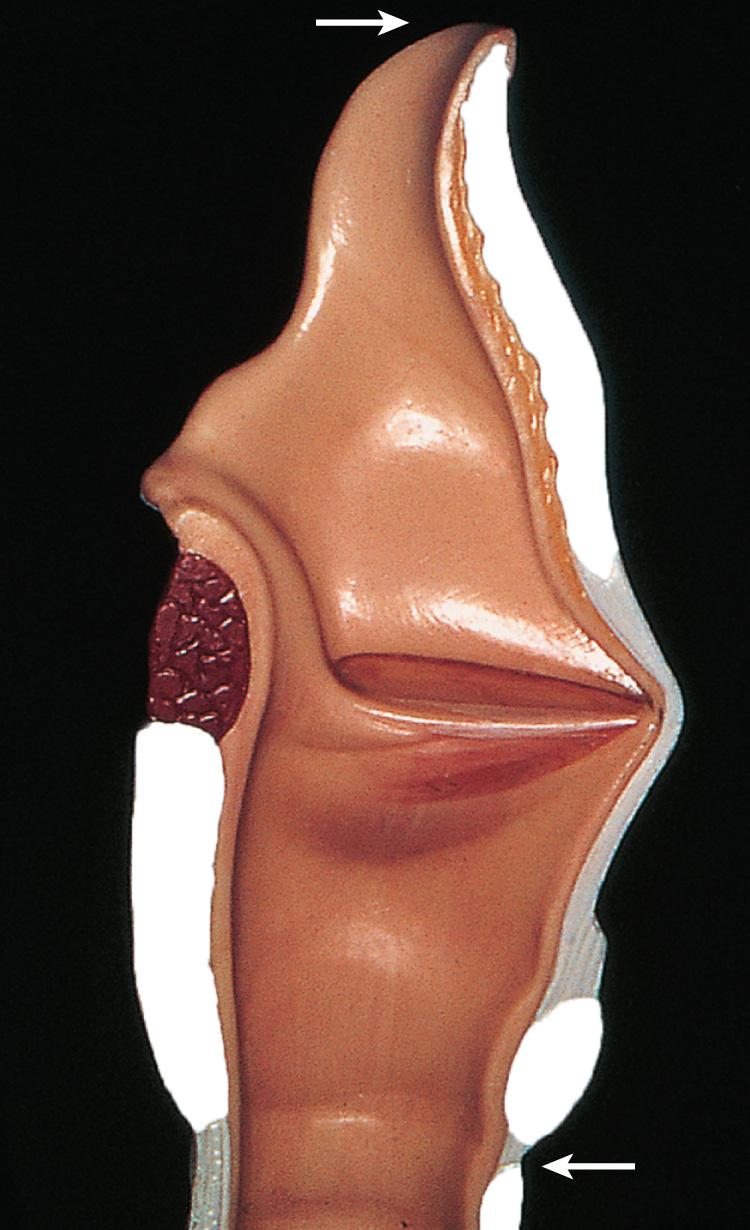
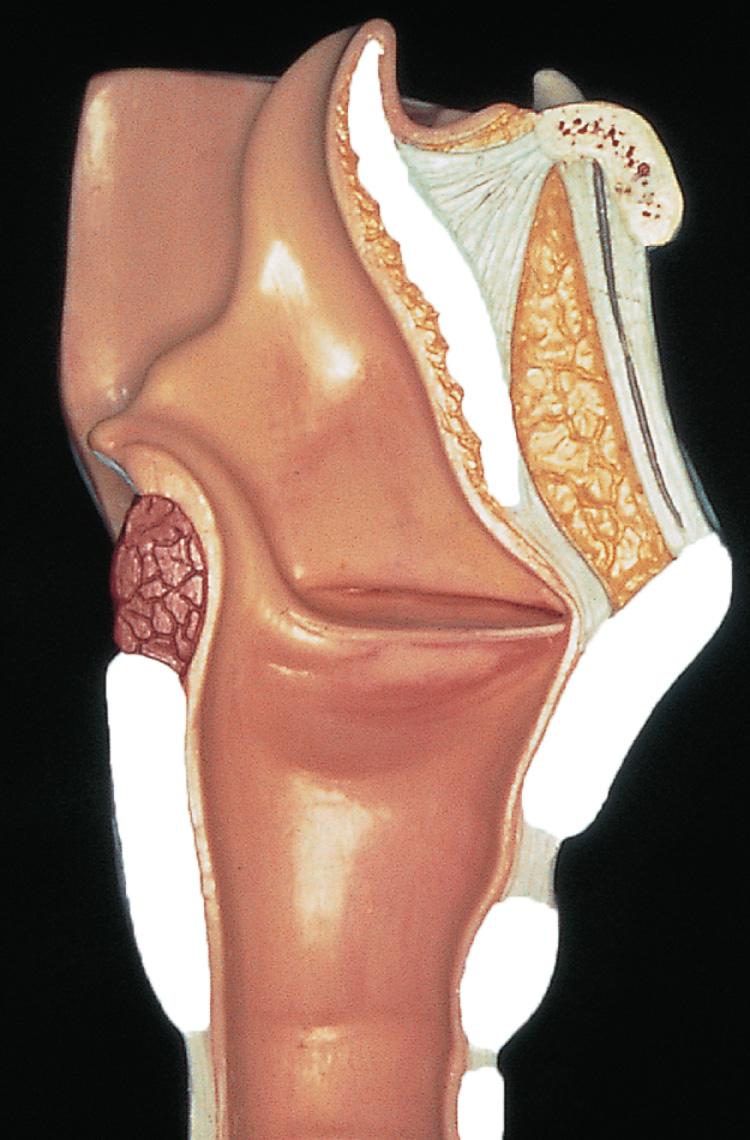
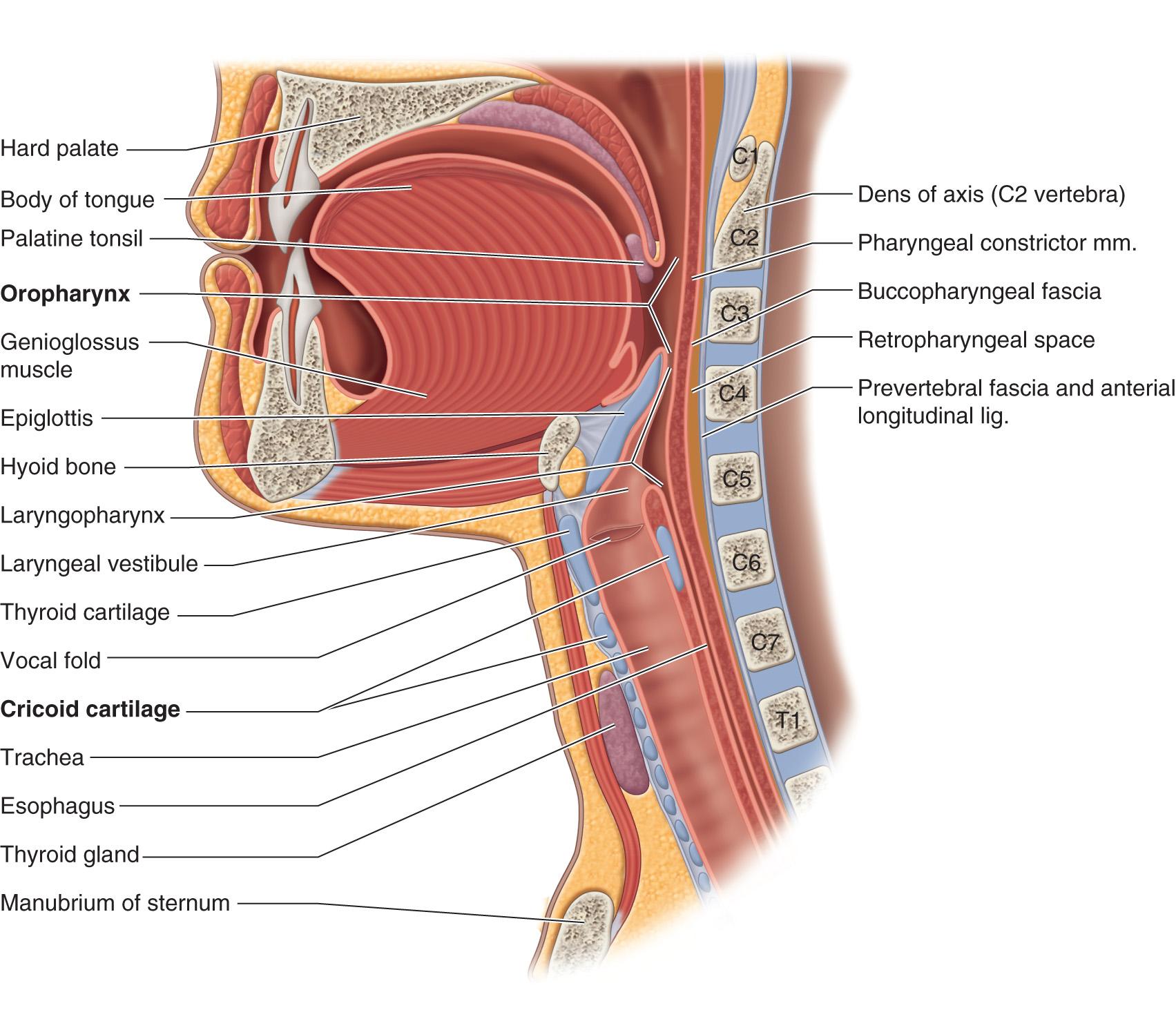
The surface mucosa of the larynx consists of squamous epithelium with interspersed mucous glands. The true vocal cords are lined by stratified squamous epithelium. The sensory nerve supply to the supraglottic larynx is provided by the internal branch of the superior laryngeal nerve, which enters the larynx through the thyrohyoid membrane. The mucosa of the true vocal cords derives dual sensory nerve supply from the superior laryngeal and recurrent laryngeal nerves, whereas the subglottic larynx derives sensory supply from the recurrent laryngeal nerve. The intrinsic musculature of the larynx derives its innervation from the recurrent laryngeal nerve except for the cricothyroid muscle, which is innervated by the external laryngeal branch of the superior laryngeal nerve. The larynx derives its blood supply from branches of the superior and inferior thyroid arteries. These vessels enter the larynx accompanied by the superior and recurrent laryngeal nerves. The supraglottic larynx has a rich lymphatic network draining through the thyrohyoid membrane into first-echelon lymph nodes at levels II and III. The lymphatic network of the glottic larynx is very sparse, especially the free edge of the true vocal cord, which is devoid of lymphatics. The lymphatic drainage of the subglottic larynx exits through the cricothyroid membrane to drain into the paratracheal and deep jugular lymph nodes. The perithyroid and Delphian lymph nodes also receive lymphatic drainage from the larynx.
All patients undergoing surgery for laryngeal cancer should undergo assessment of preoperative pulmonary function. This assessment is particularly important for persons who have a history of chronic obstructive pulmonary disease and are being considered for conservation surgery. Preoperative counseling regarding cessation of smoking is crucial. Patients dependant on smoking tobacco consumption are counseled and put on a nicotine withdrawal program. Similarly, preoperative counseling regarding postoperative pulmonary care and breathing exercises is vitally important. Consultation and counseling from a speech pathologist is essential for patients for whom a total laryngectomy is planned. Alternatives regarding speech rehabilitation are discussed at this meeting. A preoperative visit reduces the patient's anxiety and apprehension regarding loss of speech and results in improved understanding of voice rehabilitation after surgery.
The need to accurately assess the extent of a primary tumor of the larynx before selection of treatment cannot be overemphasized. The accuracy of diagnosis and selection of treatment directly depend on the extent of the primary tumor. Direct laryngoscopy is best done under general anesthesia, either with a small endotracheal tube or with jet ventilation, and requires complete relaxation to permit adequate assessment of the larynx and hypopharynx. The appropriate choice of laryngoscopes should be available in the operating room to meet the demands of varying configurations of larynges and locations of lesions. For diagnostic purposes and biopsy, a Dedo or Jako laryngoscope allows a binocular view of the larynx. A bivalved laryngoscope offers a comprehensive view of the supraglottic region and hypopharynx and is preferred for endoscopic laser resection.
Detailed endoscopic evaluation of the larynx requires the use of telescopes (0, 30, 70, and 120 degrees) to accurately evaluate the anterior commissure, the ventricles, and the subglottic region. The details of the views obtained through telescopes of various angles are shown in Fig. 10.54 , in a patient with glottic carcinoma involving both vocal cords. Such detailed evaluation of a laryngeal lesion is crucial, regardless of the treatment selected. If the patient is suitable for endoscopic surgery, the procedure begins after photo documentation of the lesion. On the other hand, if the patient is to have other treatment (e.g., radiotherapy or chemotherapy/radiotherapy), then after adequate photo documentation and biopsy the procedure is terminated.
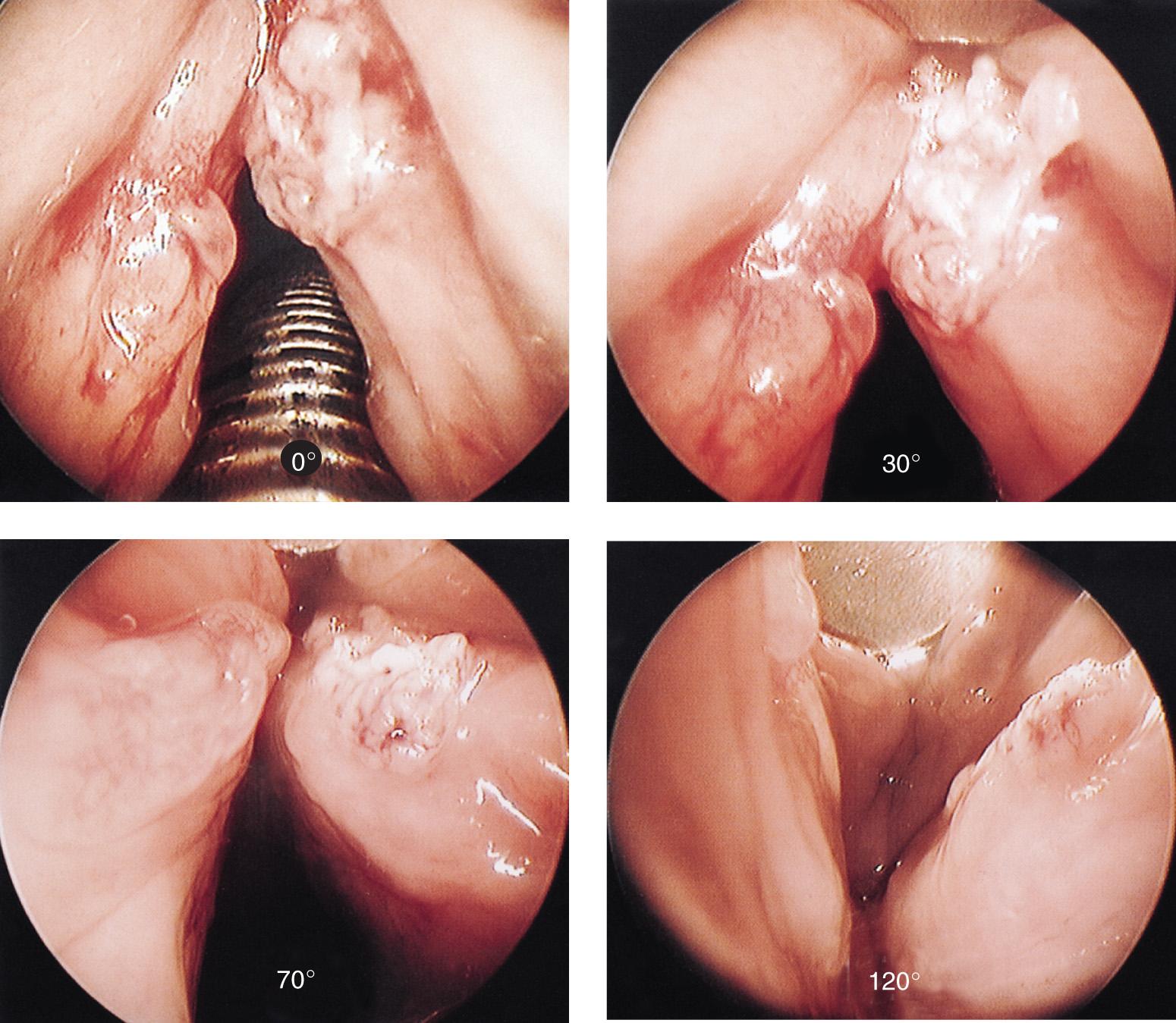
For endoscopic laryngeal surgery, the patient is placed under general anesthesia with a small endotracheal tube or on jet ventilation, and the larynx is suspended with appropriate laryngoscope and suspension equipment. An endoscopic view of the larynx as seen through the operating microscope with a 40× magnification shows a mucosal polyp involving the middle third of the left true vocal cord ( Fig. 10.55 ). The remaining larynx is unremarkable. The polyp is grasped with an angled biopsy forceps as shown in Fig. 10.56 , and with the use of angled scissors with its tip to the right, the mucosal polyp is excised in toto. No attempt should be made to excise any part of the underlying musculature since this is a lesion of only the mucosa; otherwise, the voice quality could be adversely affected. Excision of the polyp in progress is shown in Fig. 10.57 . Every attempt must be made to remove the entire specimen in one piece. The whole specimen should be fixed in a paraffin block for accurate histologic processing after its orientation by the operating surgeon for the pathologist regarding its anterior, posterior, superior, and inferior margins. Hemostasis is obtained by gentle pressure with a cotton pledget soaked in adrenaline diluted in saline solution ( Fig. 10.58 ). Bleeding from tiny vessels is usually controlled in this manner ( Fig. 10.59 ). Hemostasis of minor bleeding can be secured by cauterization with silver nitrate or with the use of a low-power carbon dioxide laser.
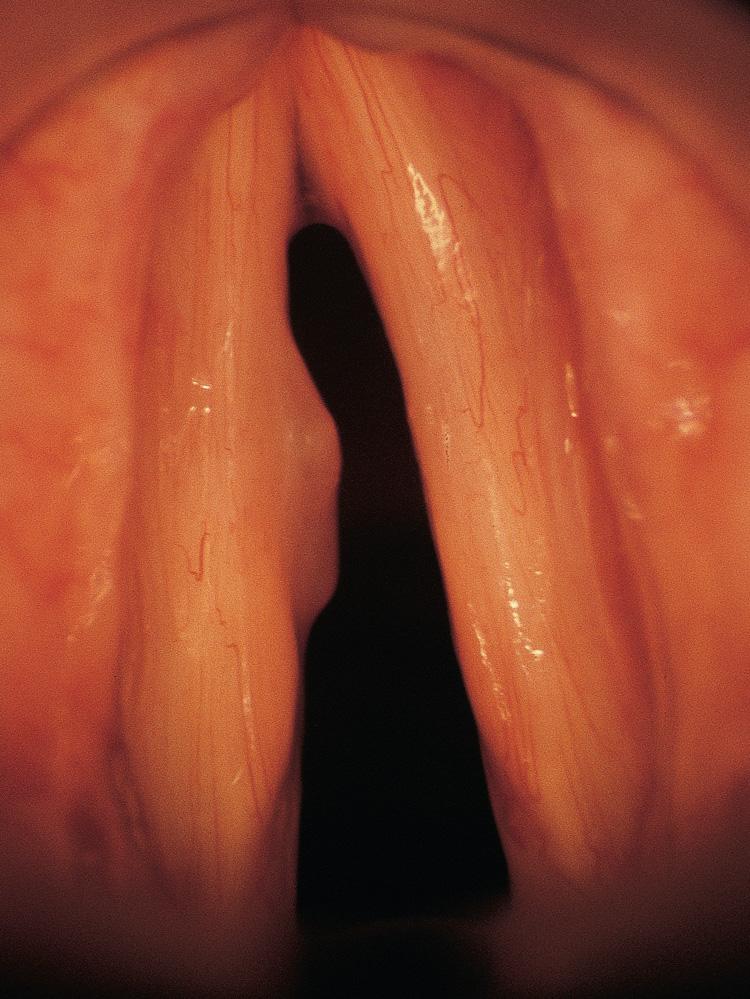
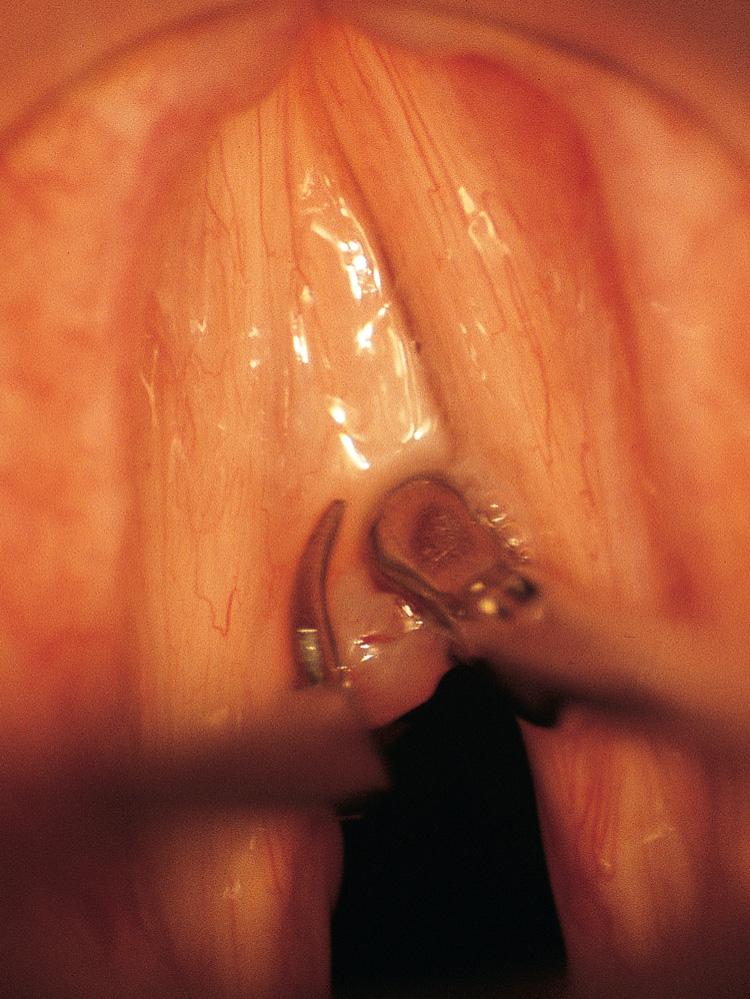
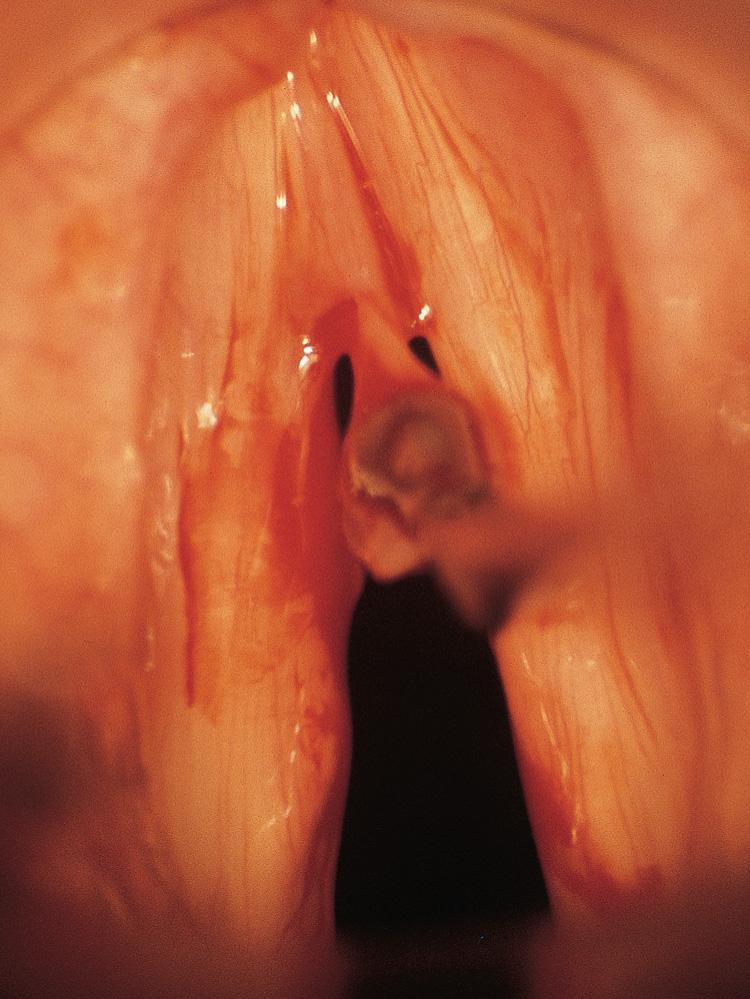
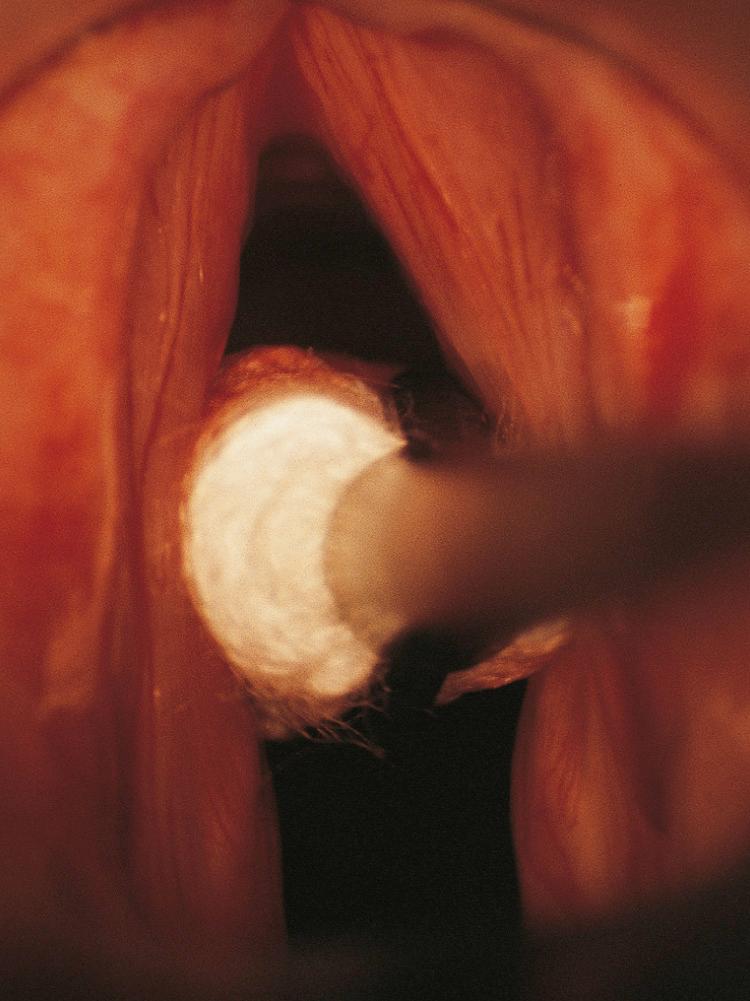
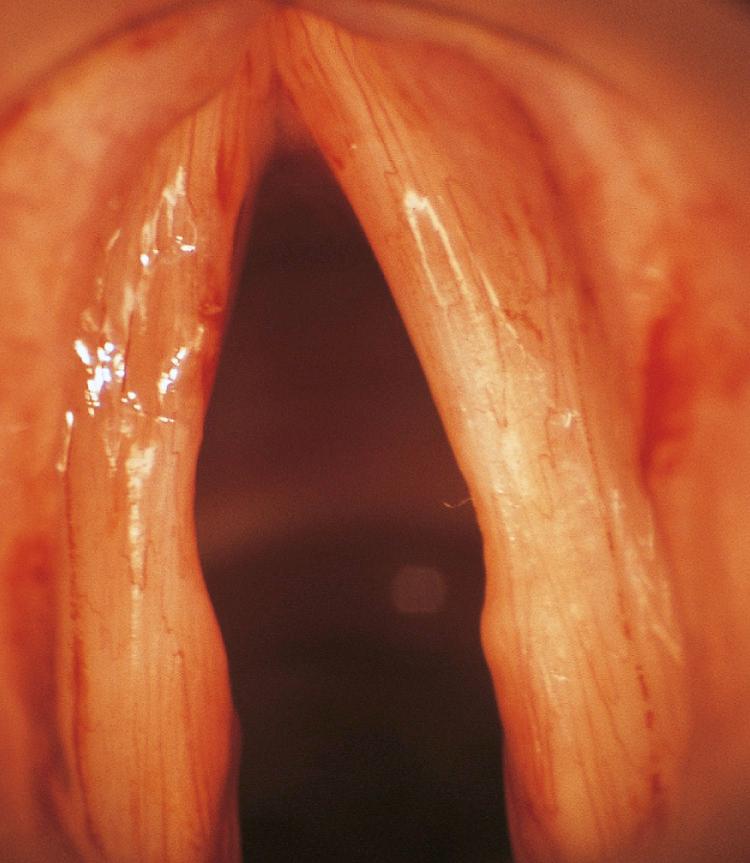
During endoscopic laryngeal surgery, 4 mg of dexamethasone is administered, which is continued every 6 hours and is tapered off during the next 48 hours. The purpose of administering steroids is to reduce laryngeal edema and occasional respiratory difficulty in the immediate postoperative period. A regular diet is permitted by mouth, but the patient is advised to remain on voice rest until satisfactory epithelialization of the vocal cords takes place. In general, voice rest is recommended for approximately 1 week after vocal cord surgery.
Various other benign and early malignant lesions of the larynx are considered suitable for management through endoscopic microlaryngeal surgical techniques. Use of the carbon dioxide laser may be considered appropriate under select circumstances for benign lesions and for some patients with malignant disease.
Mucosal lesions of the true vocal cord that are relatively flat require special attention during microlaryngeal surgery. Because these lesions do not have an exophytic component, they are difficult to grasp and lift away from the underlying submucosa of the true vocal cord. Thus if the lesion is grasped and excision is performed in the usual manner, the probability of lacerating and fragmenting the specimen or of sacrifice of the underlying vocalis muscle is high. Lesions such as these therefore are excised endoscopically with use of the hydrodissection technique. The patient shown in Fig. 10.60 has superficial keratosis of the left true vocal cord in its anterior third. The lesion is flat and has minimal exophytic component. To lift the lesion from the underlying vocalis muscle, normal saline solution with epinephrine (adrenaline) is injected in the submucosal plane. A long mediastinal 25-gauge needle is attached to a 5-mL syringe. One milliliter of epinephrine (1 : 50,000) is mixed with 5 mL of normal saline solution. The needle is introduced through the laryngoscope, and the saline solution is injected in the submucosal plane of the anterior half of the left true vocal cord ( Fig. 10.61 ). The injected amount should be just sufficient to elevate the lesion. Overinjection should be avoided; otherwise, it will distort the anatomy. Note that the lesion is now lifted from the underlying vocalis muscle and is easy to grasp and excise without sacrifice of normal tissue ( Fig. 10.62 ).
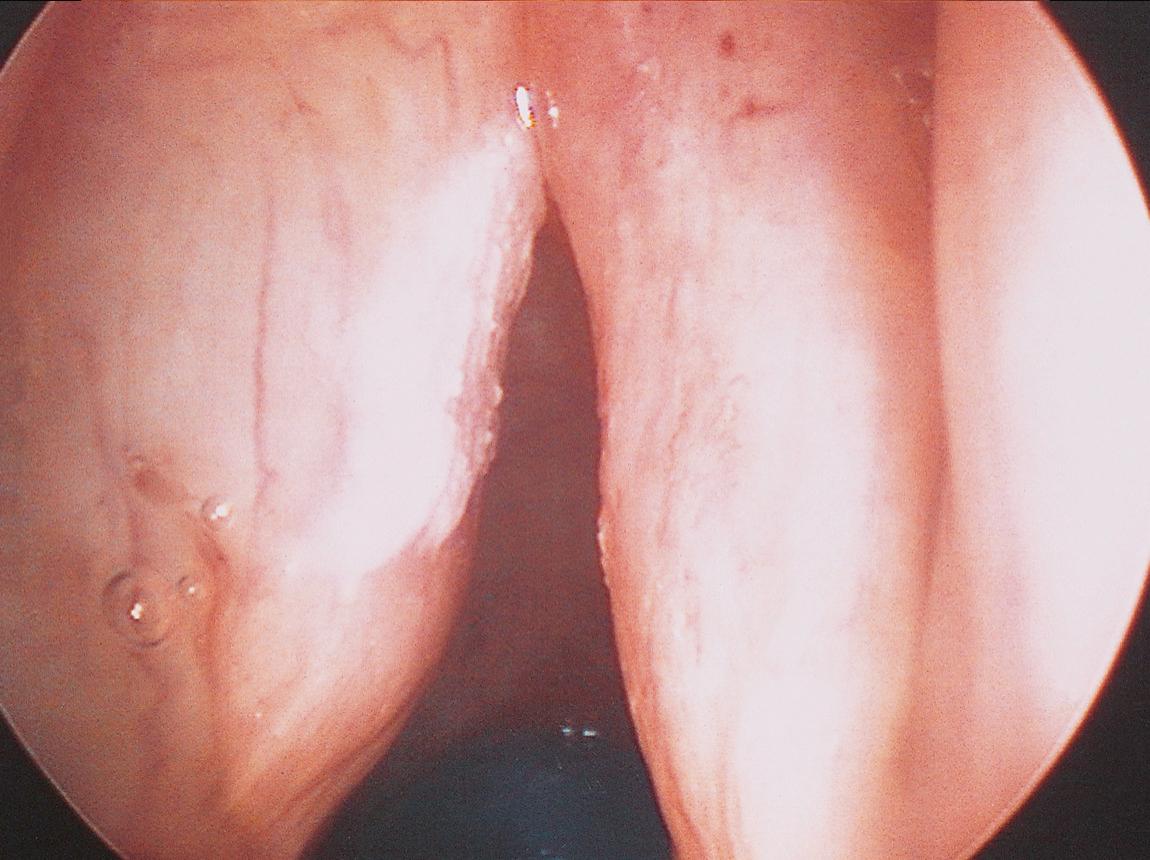
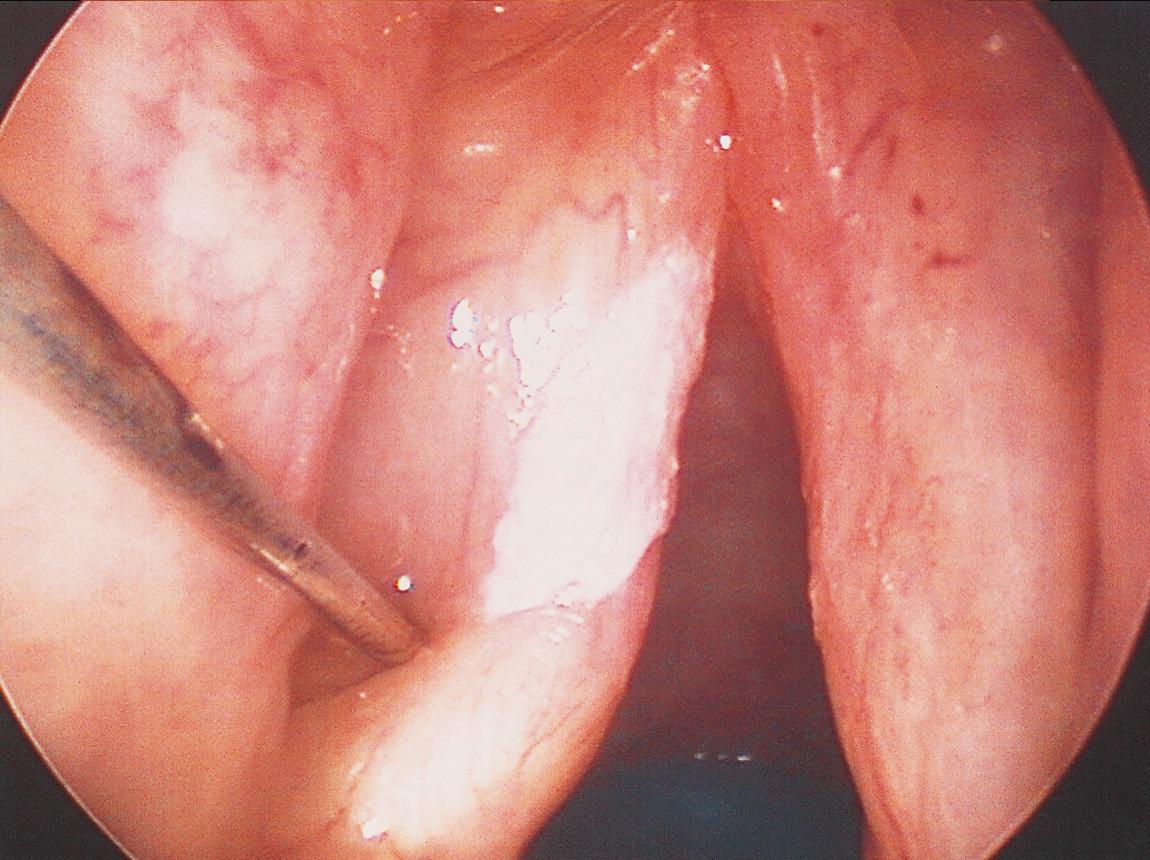
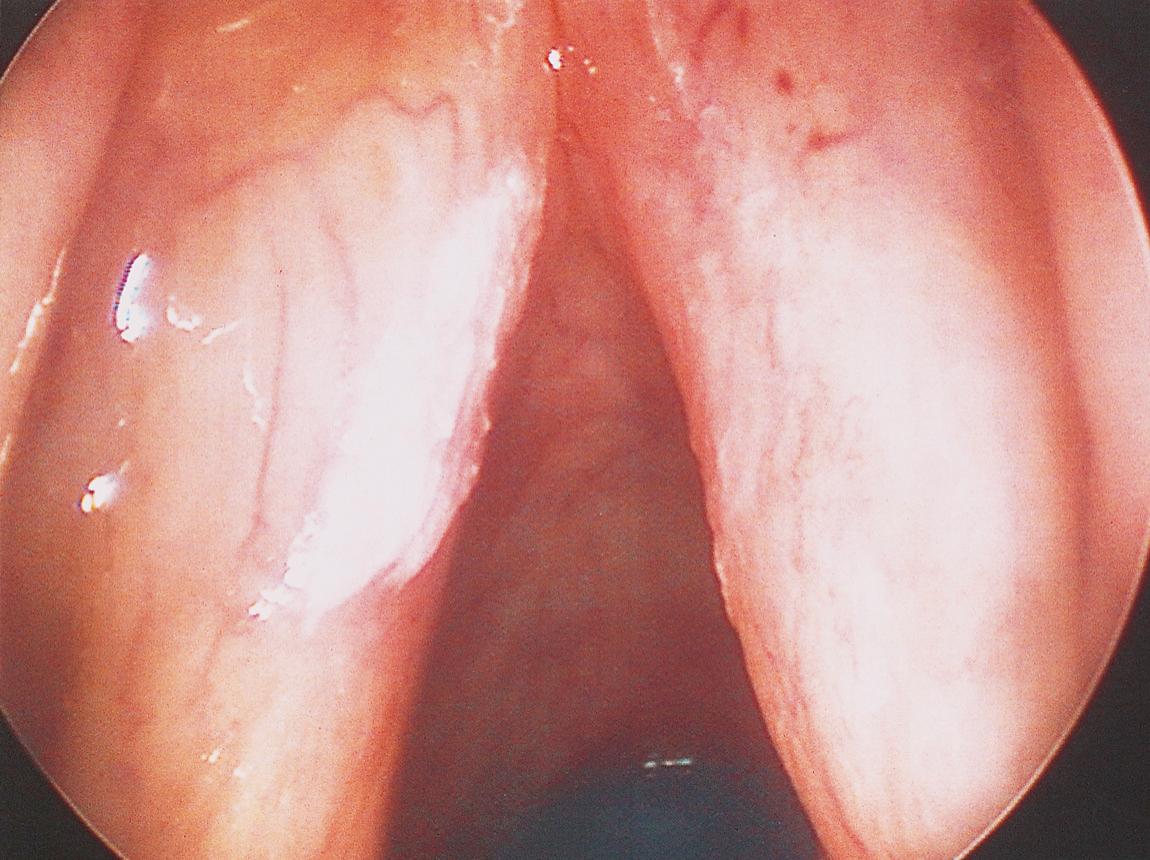
The lesion is grasped with a small biopsy forceps and retracted toward the midline. Curved scissors with the tip to the right are used to excise the lesion in a monobloc fashion ( Fig. 10.63 ). Every attempt must be made to excise the lesion in one piece. The surgical defect following excision of the lesion is seen in Fig. 10.64 . Hemostasis for minor bleeding points is controlled with cotton pledgets soaked in epinephrine diluted in saline solution. If further bleeding is encountered, it may be controlled with silver nitrate cauterization, electrocautery, or a carbon dioxide laser.
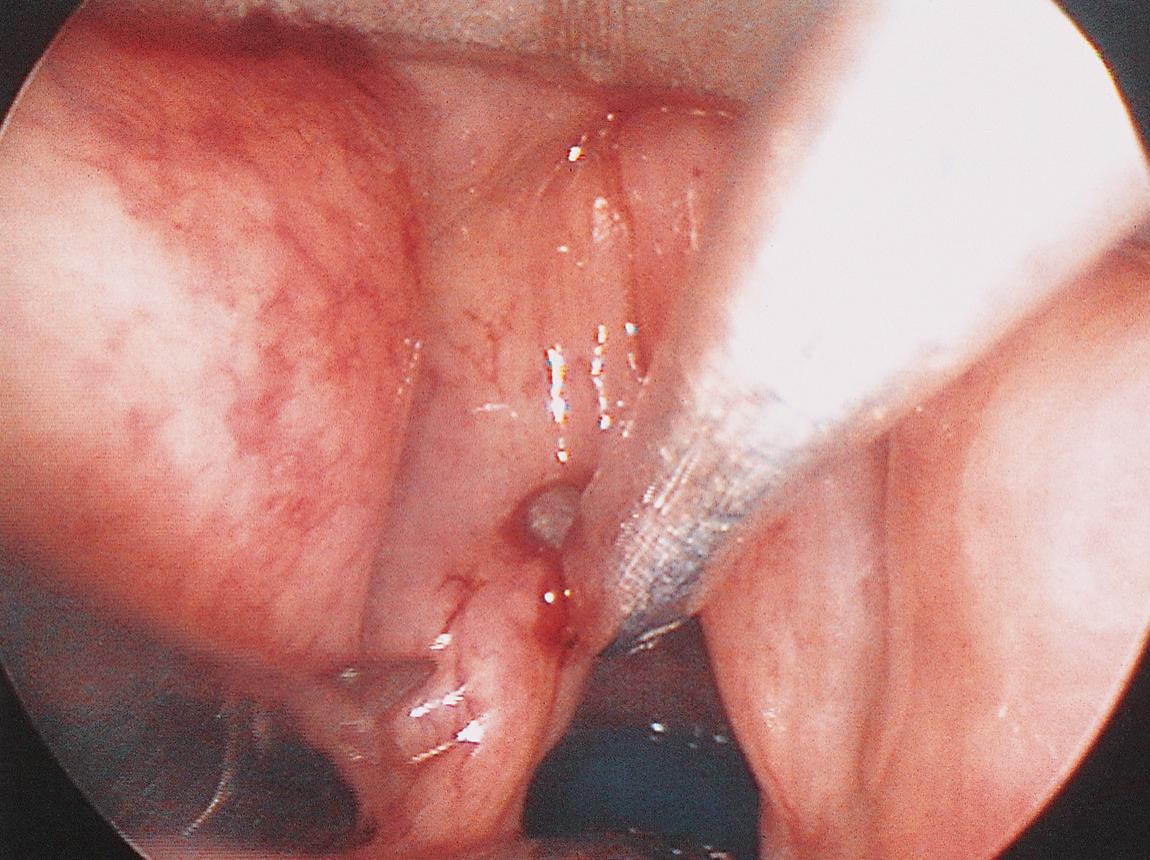
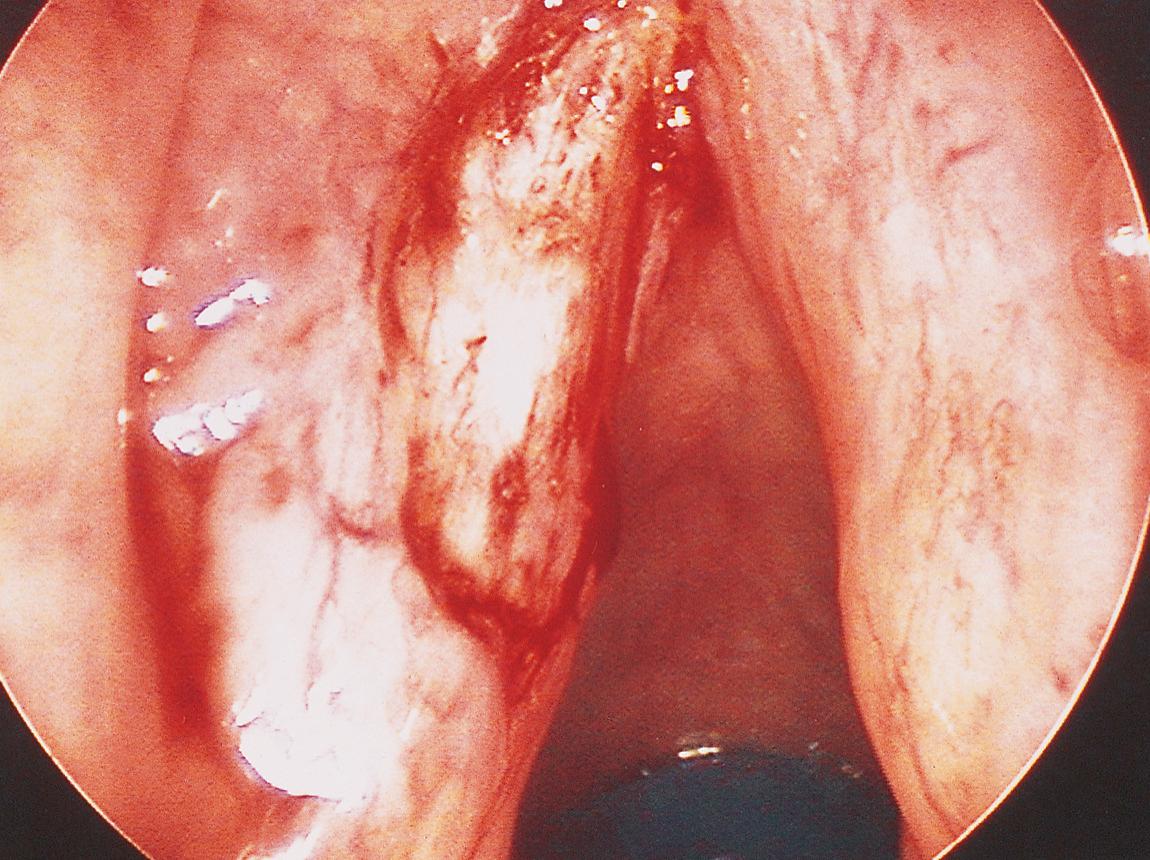
Another patient with carcinoma in situ of the right true vocal cord with the lesion confined strictly to the mucosa of the vocal cord, suitable for endoscopic excision with the hydrodissection technique, is shown here. The endoscopic view of the larynx with 0-degree, 30-degree, 70-degree, and 120-degree telescopes show that the lesion is confined to the mucosa of the free edge of the vocal cord ( Fig. 10.65 ). Endoscopic view of the larynx after excision shows only loss of the mucosa of the vocal cord, which will spontaneously epithelize, with return of normal voice ( Fig. 10.66 ).
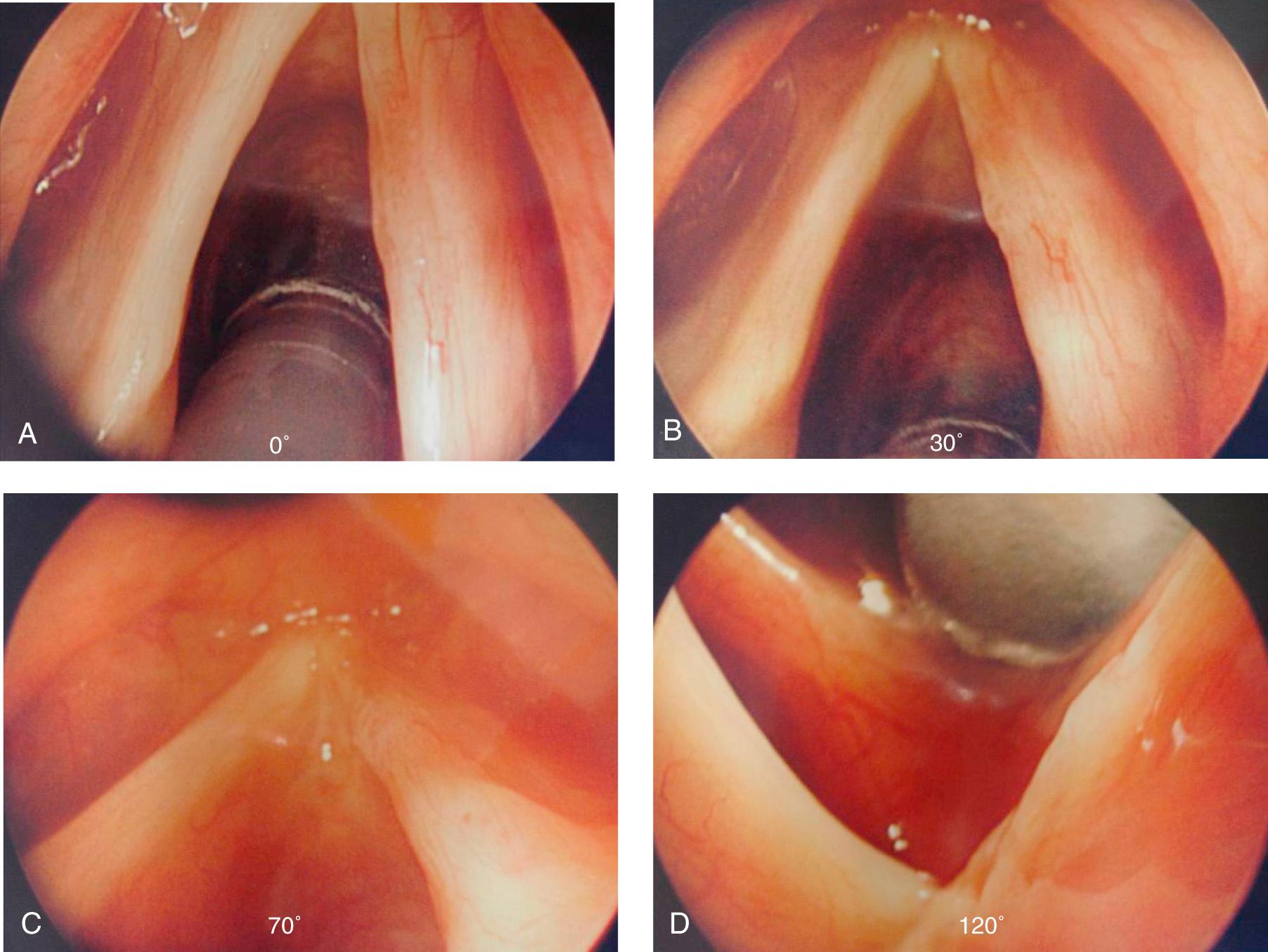
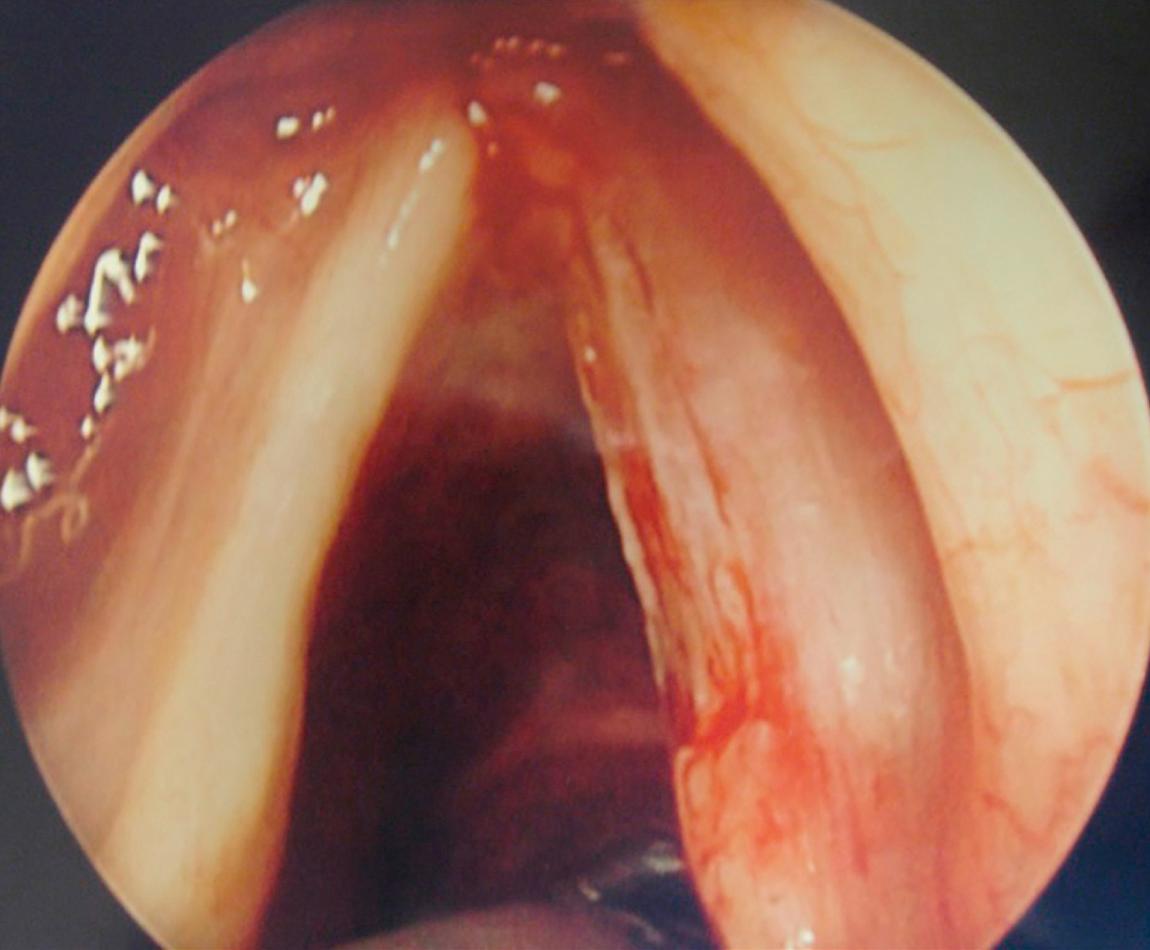
Become a Clinical Tree membership for Full access and enjoy Unlimited articles
If you are a member. Log in here